Powered by Blogger.
Categories
- Art Journal (85)
- Life Art (72)
- Mixed Media (53)
- Gauche Alchemy (34)
- deep thoughts (28)
- Hipstamatic (26)
- African Well Fund (20)
- Bono (17)
- Hipstamatic Gallery (12)
- Hipstamatic + Mixed Media (11)
- Gelli Prints (10)
- Hipstamatic Travels (10)
- Tattoo (8)
- Greeting Card (5)
- Tips and Techniques (4)
- LifeBook 2014 (3)
- DLP (2)
- Gifts (2)
- Published (2)
- travel (2)
- Quotes (1)
- scrapbook (1)
Archive for June 2013
Old Car City - Hipstamatic Style

Last weekend i visited Old Car City in White, Georgia. About an hour and a half from Atlanta. Interesting place . . . a bit overwhelming . . . a bit inspirational . . . a nice stroll on a nice day . . .
I think what everything in my life comes down to are these words.
Perhaps some day i can make a living off of that philosophy.
Here and there were these handwritten signs. At first they were disturbing my flow since i had thought i was there to look at the old cars, but soon my focus shifted and i sought them out. I love the folk artiness of it. The mispellings. The universal sentiments...
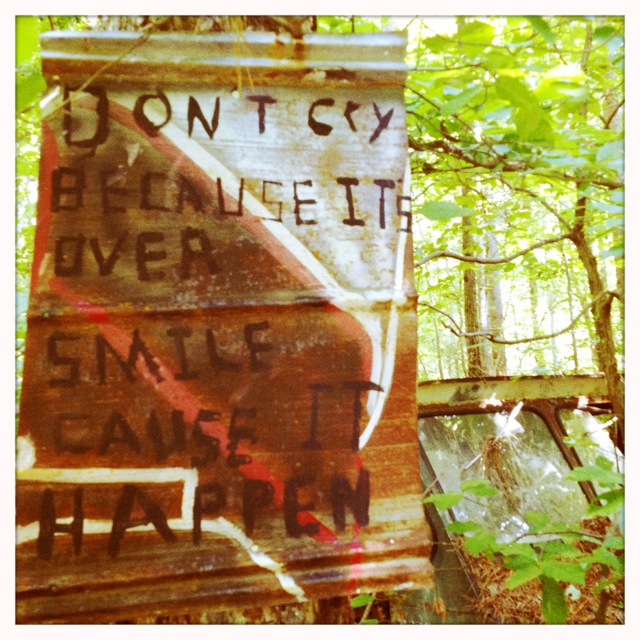
and of course, the moral to every story . . .
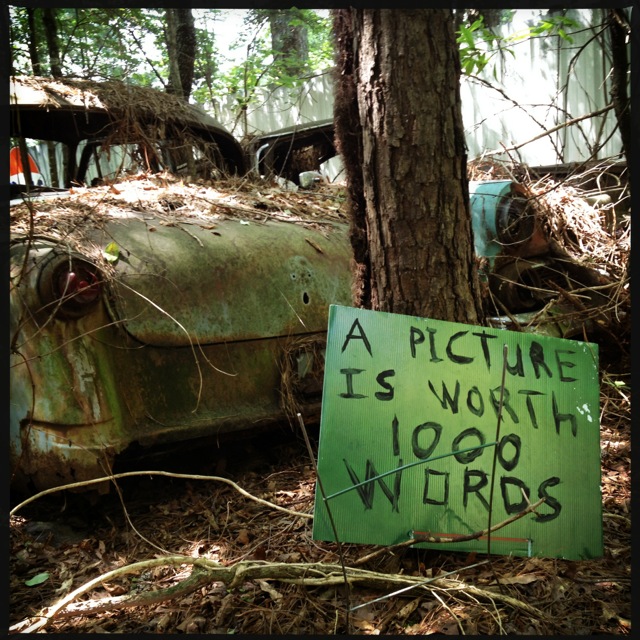
But, there were cars too! So so so many.
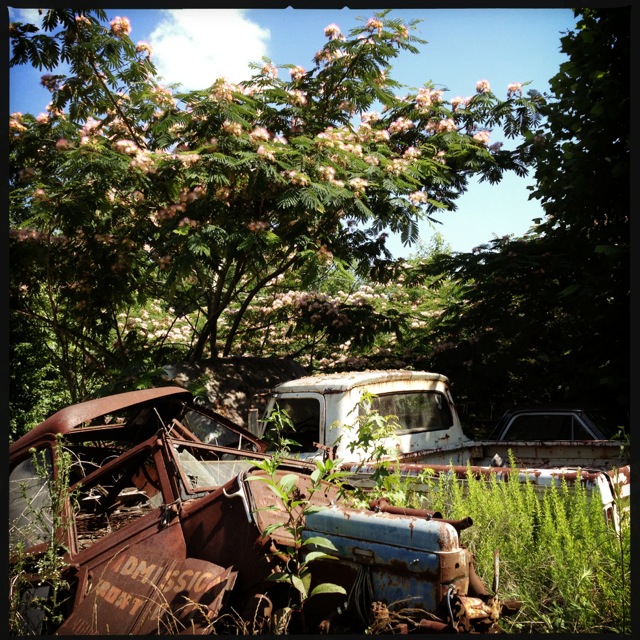

And buses . . .
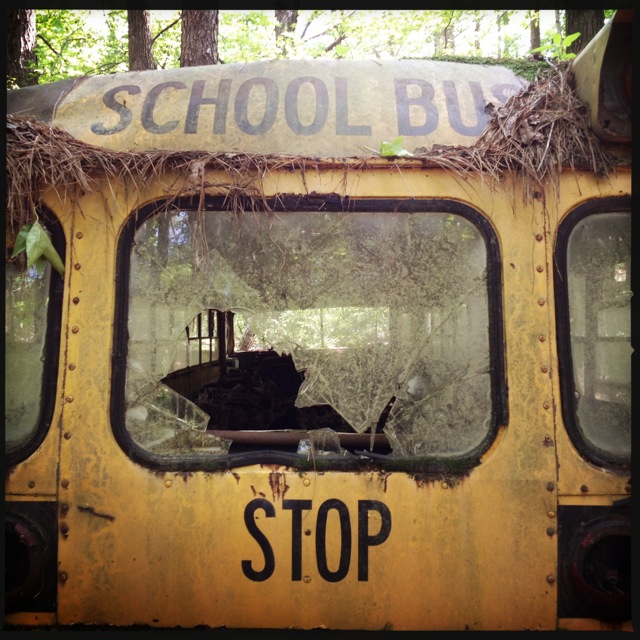
And amazing pantina's and paint and rust that i will try as hard as i can to replicate . . .
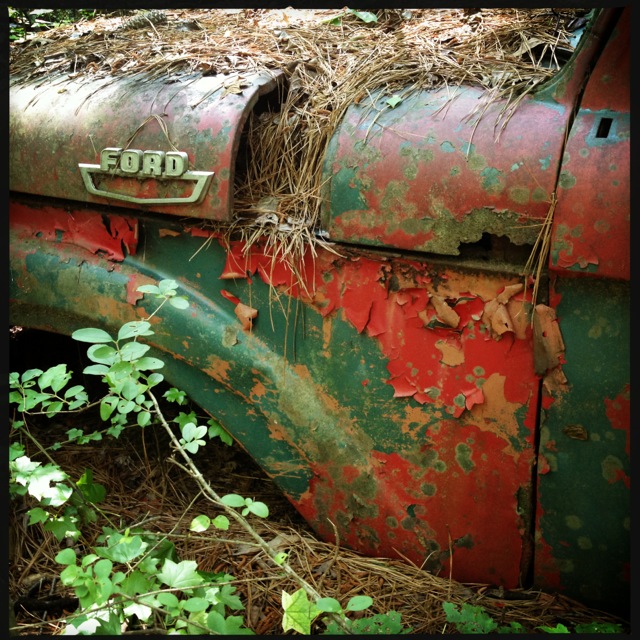

Look forward to going back soon, although note to self, bring bug spray!!!
Tag :
Hipstamatic,
Hipstamatic Gallery,
Hipstamatic in Paris
After spending 6 days in West Africa, i stopped over in Paris with three others. It was somewhat of an unfortunate time for my first visit to the city, but nonetheless i'm glad we spent three days there.
Now, my goal is to learn French and return for a longer visit to Paris as well as Southern France!
Here are some obligatory photos of the Eiffel Tower through the lense of Hipstmatic:
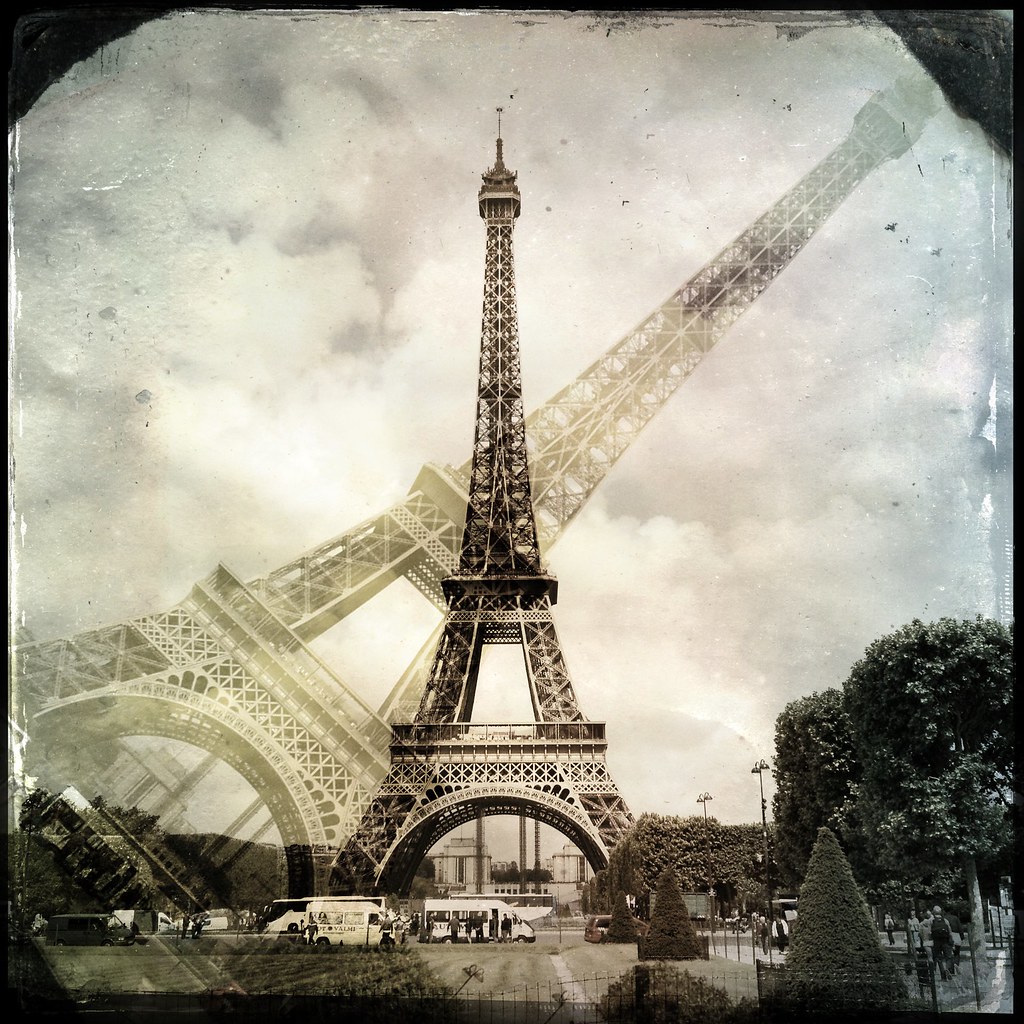

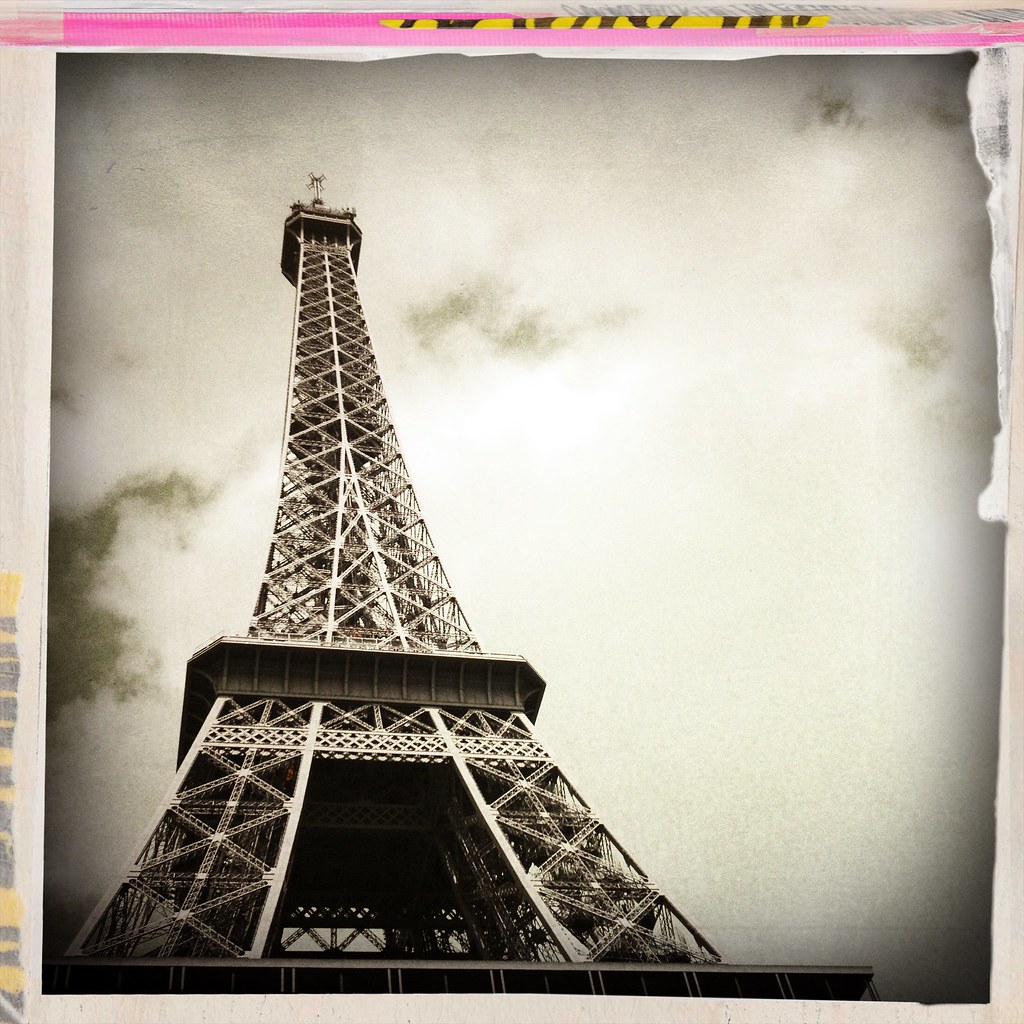
And then my other favorite photographic passion, statuary (which Paris is ripe with!!!):
At the Louvre, this is the Cupid and Psyche statue:

One of the 100s of cupids and angels that line the Seine river bridges:

At La Basilique du Sacré Coeur de Montmartre:

At Tuileries Garden - Leveque's Nymph:
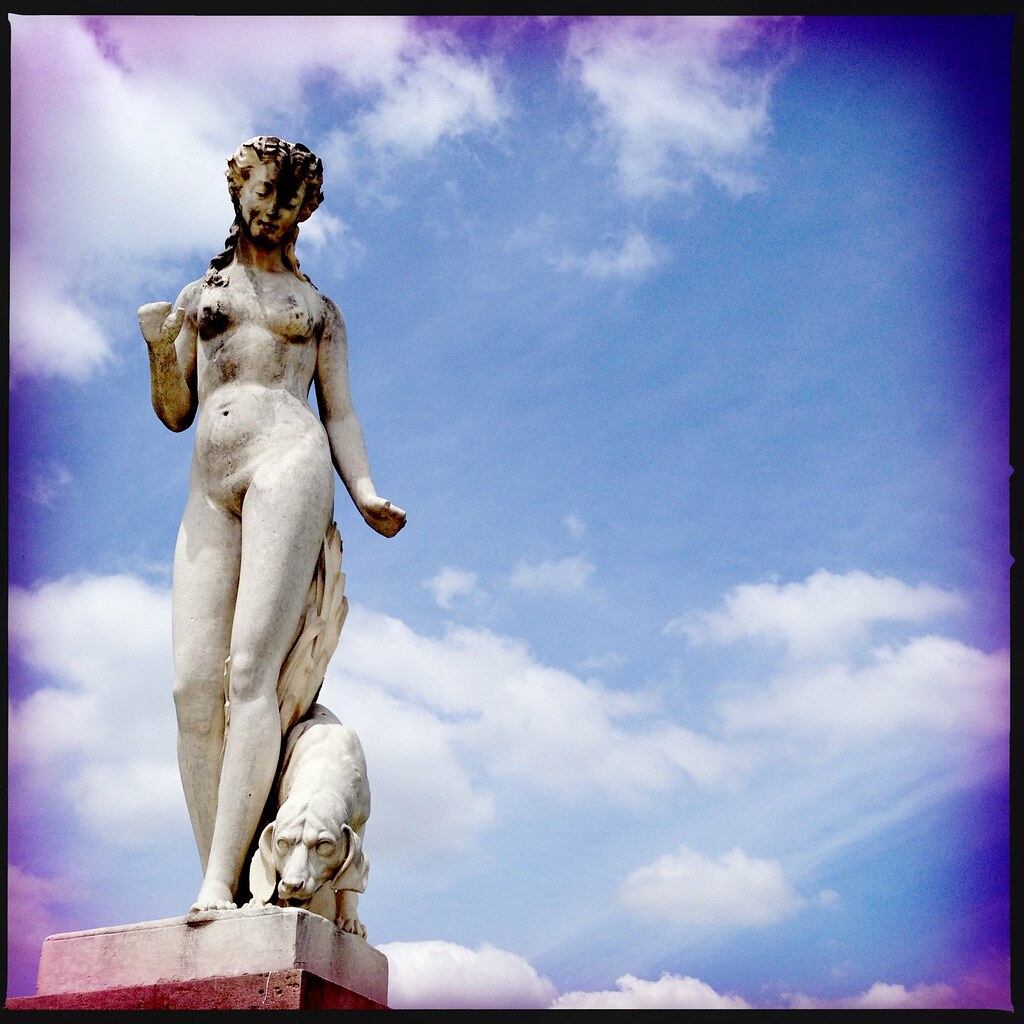
On the wall of the Museo of Modern Art:
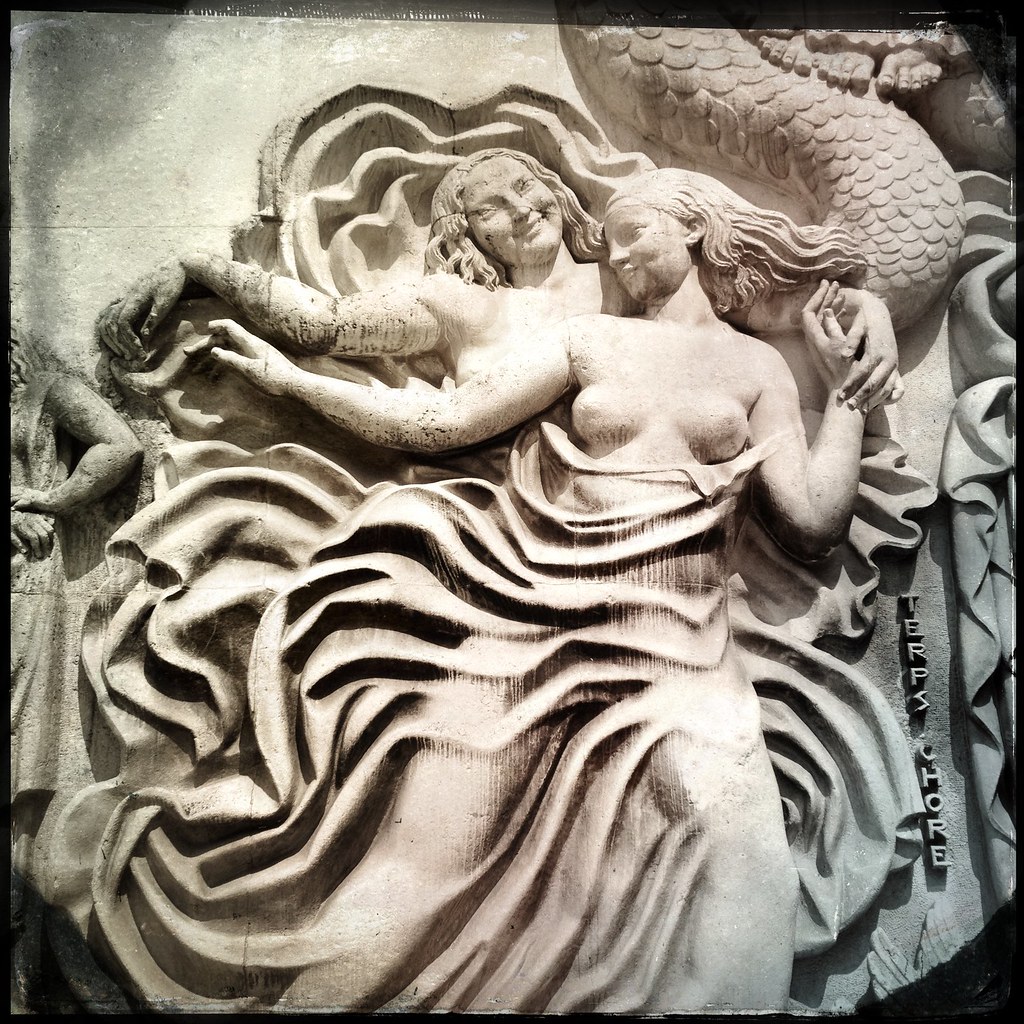
At the Montmartre Cemetery:
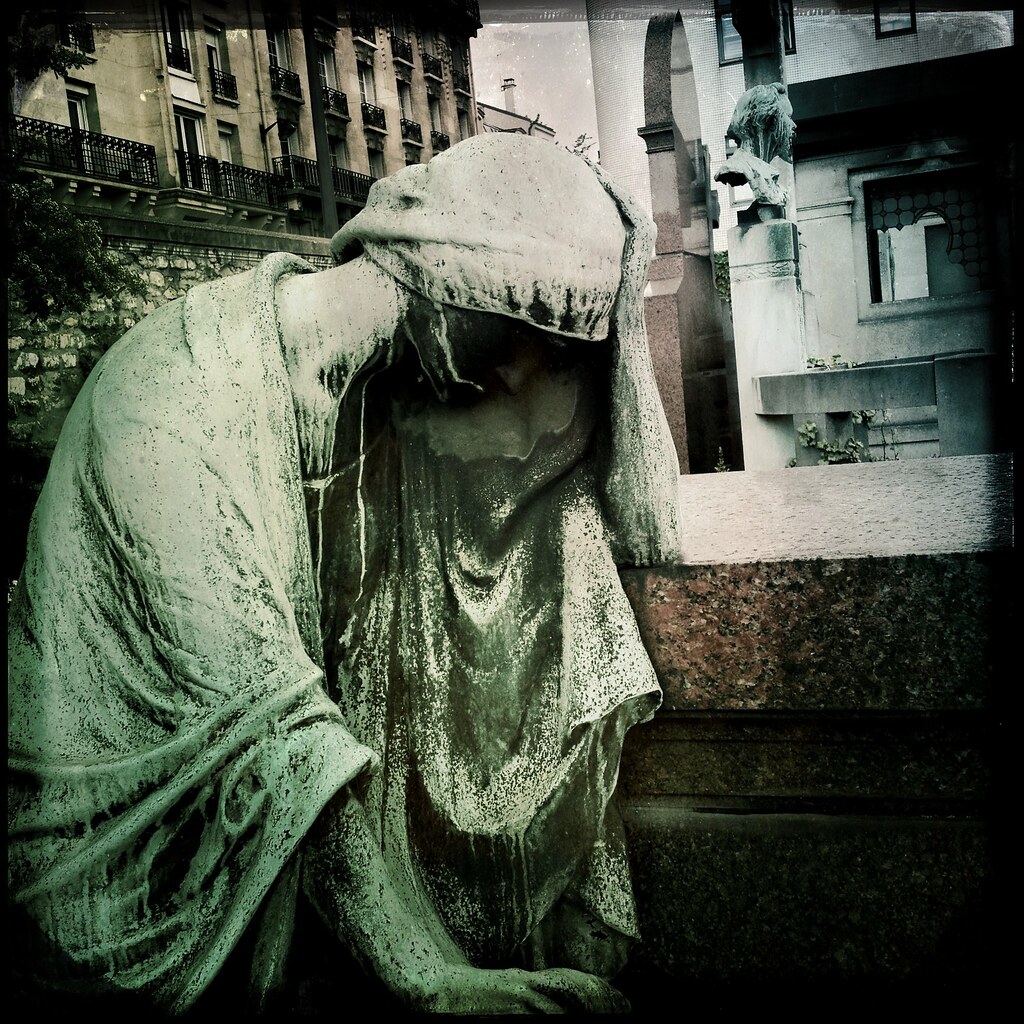
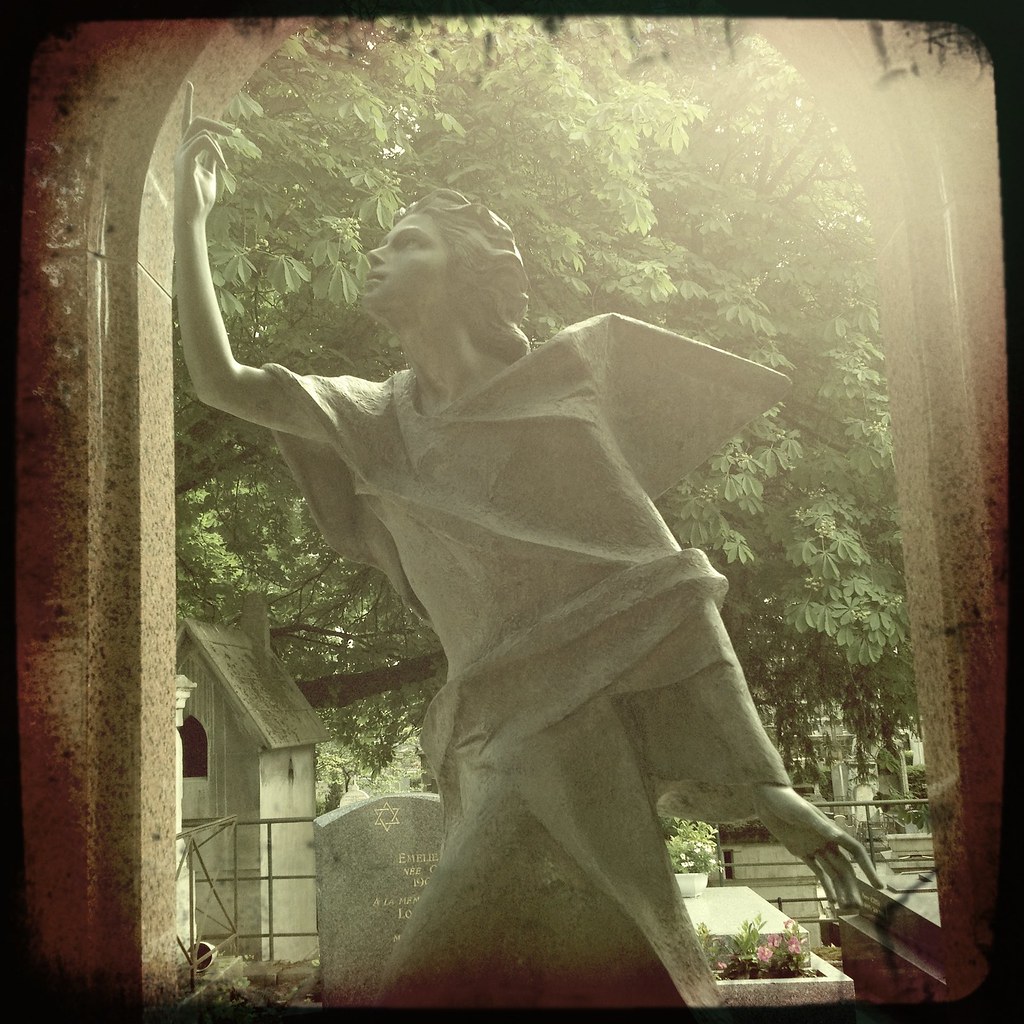
To see other travels via the Hipstamatic viewfinder:
Central Wisconsin
House on the Rock, Wisconsin
Southern California
Austin Texas
Tennessee and North Carolina
Atlanta Oakland Cemetary
New Orleans
Washington DC
Lomé, Togo
Ganvié, Benin
Bohicon, Benin
To see the current nine volumes of photographs:
Volume One
Volume Two
Volume Three
Volume Four
Volume Five
Volume Six
Volume Seven
Volume Eight
Volume Nine
Now, my goal is to learn French and return for a longer visit to Paris as well as Southern France!
Here are some obligatory photos of the Eiffel Tower through the lense of Hipstmatic:



And then my other favorite photographic passion, statuary (which Paris is ripe with!!!):
At the Louvre, this is the Cupid and Psyche statue:

One of the 100s of cupids and angels that line the Seine river bridges:

At La Basilique du Sacré Coeur de Montmartre:

At Tuileries Garden - Leveque's Nymph:

On the wall of the Museo of Modern Art:

At the Montmartre Cemetery:


To see other travels via the Hipstamatic viewfinder:
Central Wisconsin
House on the Rock, Wisconsin
Southern California
Austin Texas
Tennessee and North Carolina
Atlanta Oakland Cemetary
New Orleans
Washington DC
Lomé, Togo
Ganvié, Benin
Bohicon, Benin
To see the current nine volumes of photographs:
Volume One
Volume Two
Volume Three
Volume Four
Volume Five
Volume Six
Volume Seven
Volume Eight
Volume Nine
Tag :
Hipstamatic,
Hipstamatic Travels,
What Remains Mixed Media
and now for something a little different . . .
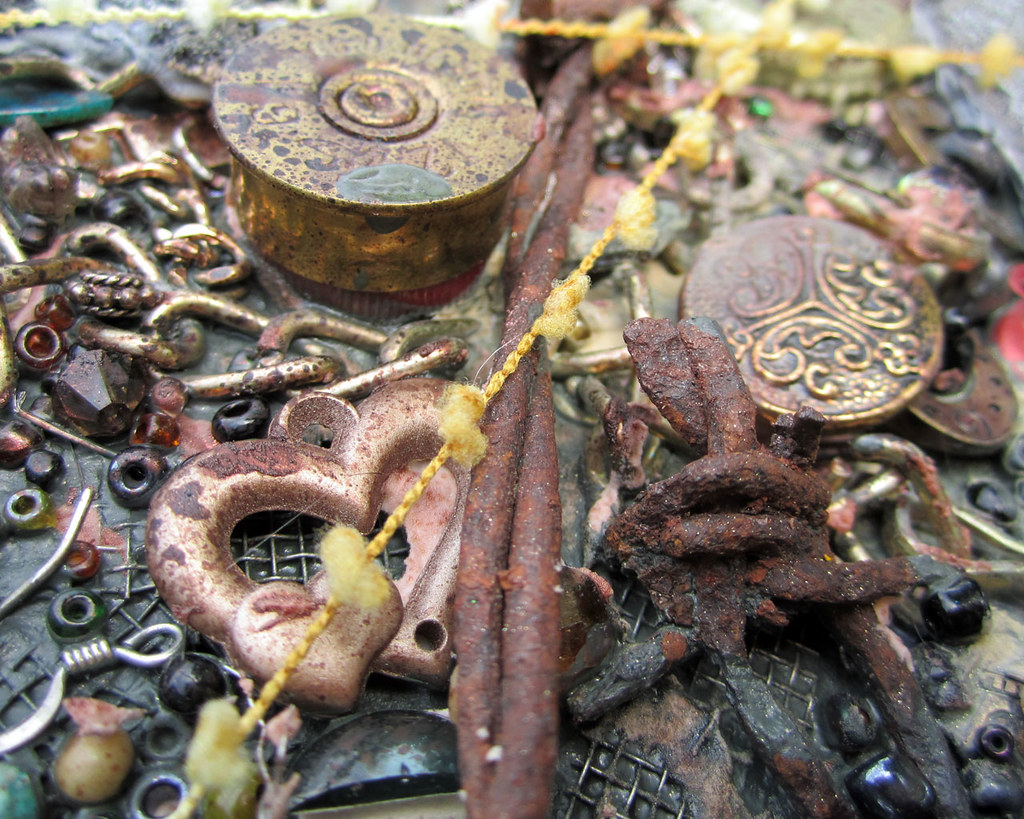
A new direction in texture i'm exploring. Finally one that turned out pretty darn well. Actually REALLY darn well . . .
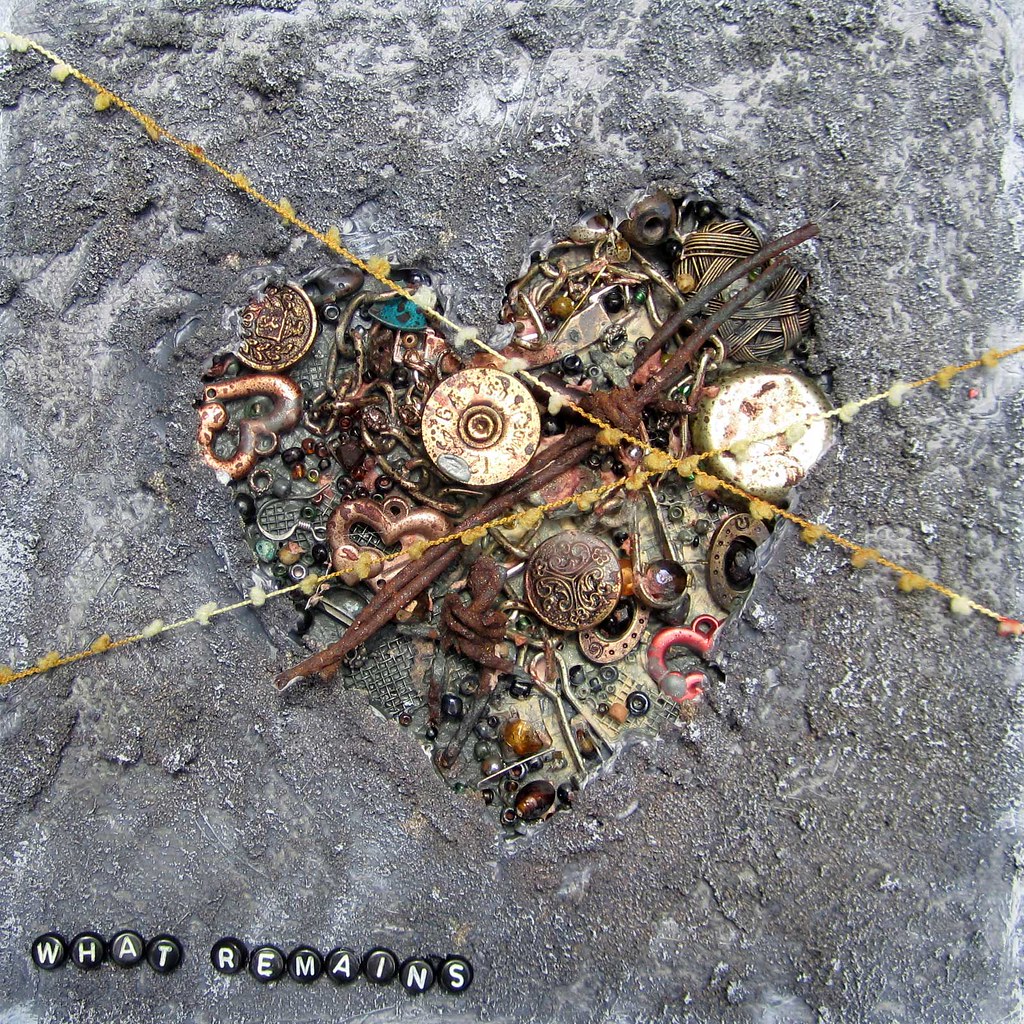

A new direction in texture i'm exploring. Finally one that turned out pretty darn well. Actually REALLY darn well . . .

Tag :
Mixed Media,
Project Day in Benin
*opinions and observations expressed here are mine and mine only. African Well Fund will be posting a recap of the same experience in the upcoming days*
The day had come that was the impetus for this trip to West Africa. We were picked up before sunrise to make the long drive towards the north central part of Benin to visit the four schools that the WASH (Water and Sanitation Hygiene) component we had funded had taken place in.
Below is a personal recollection of the day:

I had no idea what to expect - I had seen photos of African Well Fund's previous trips to schools and project report photos from Africare, but as i had already learned it's a different thing to experience it. I was very conscious of my fear and excitement about whatever lay ahead.
The trip went through "urban" areas as well as heavily vegetated areas. The urban areas were much like we had already experienced - crazy traffic between autos and motocycles, people selling a myriad of goods, dirt, exhuast mixing with the heat.
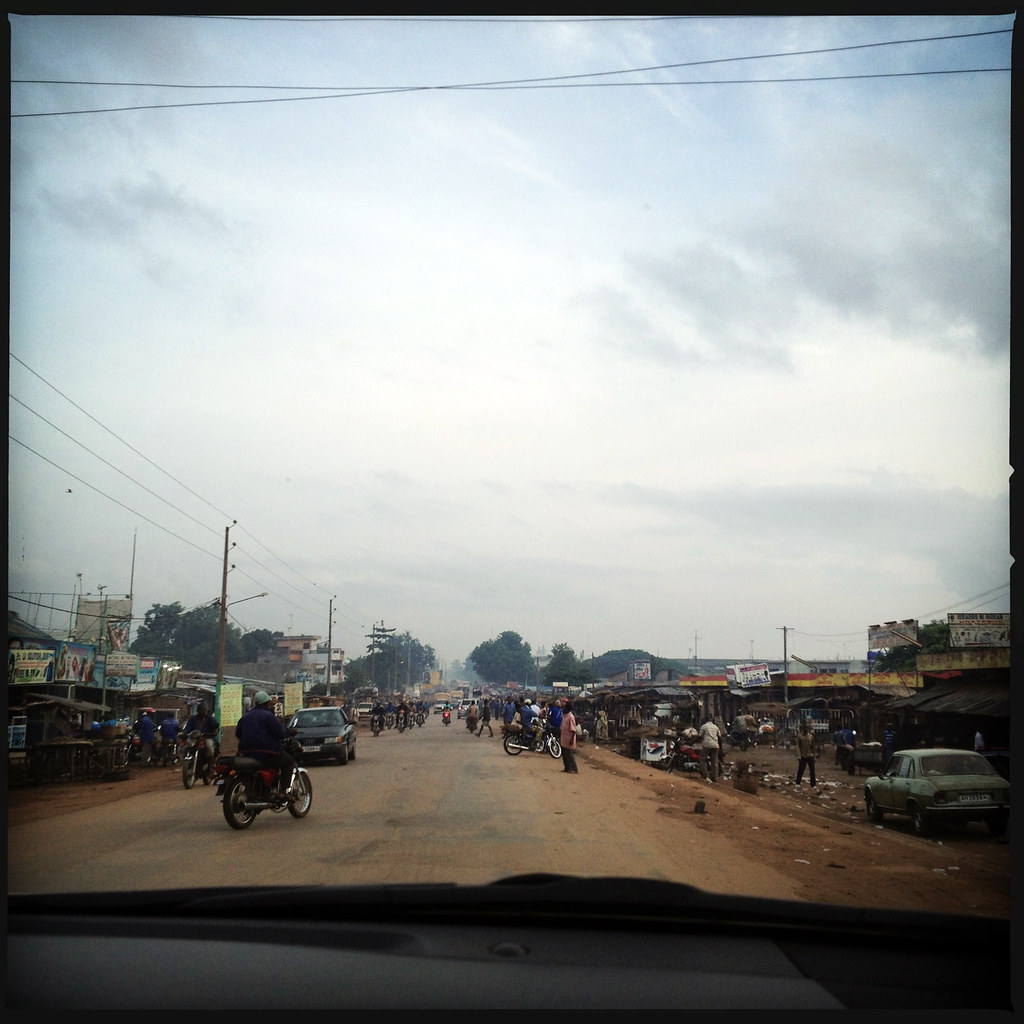
One of the cities we drove through is Porto Novo, which is the capital of Benin. It was a strange mix of 19th century Brazillian colonial looking buildings and makeshift dwellings. Everything but the mosques and churches seem to be in disrepair or half built. We were told numerous construction projects start but never get finished. And when things start falling apart there really isnt money to hire people to repair.
As we made our way out of the city and toward Bohicon, where the schools are located, it became much more agricultural, although people were walking along the side of the highway as well as in the fields harvesting fruits and vegetables. Gender roles still appear to be clearly defined in the part of West Africa we were in. Men did the hunting and gathering, women cleaned, cooked and sold whatever was abundant in their village.
The roads we travelled were lined with women and their children selling fruits and vegetables, oils and peanuts. And the product was always concentrated within the same area - you'd see a dozen women all selling the same oranges or the same corn. These seemed to be the women whose families are probably the statistics we hear about - the ones living on less than a dollar a day just doing what they know to survive.
Recent statistics show that 5% of the population in this area actually has access to clean water.
FIVE PERCENT.

I felt way too guilty to take any of their photos from the car I was in, as it seemed a luxury at this point. However, this is the image I have designed in my head based on all the different things I saw as well as things I've learned over the years on the Internet:
. . . i digress and climb down from the soapbox . . .
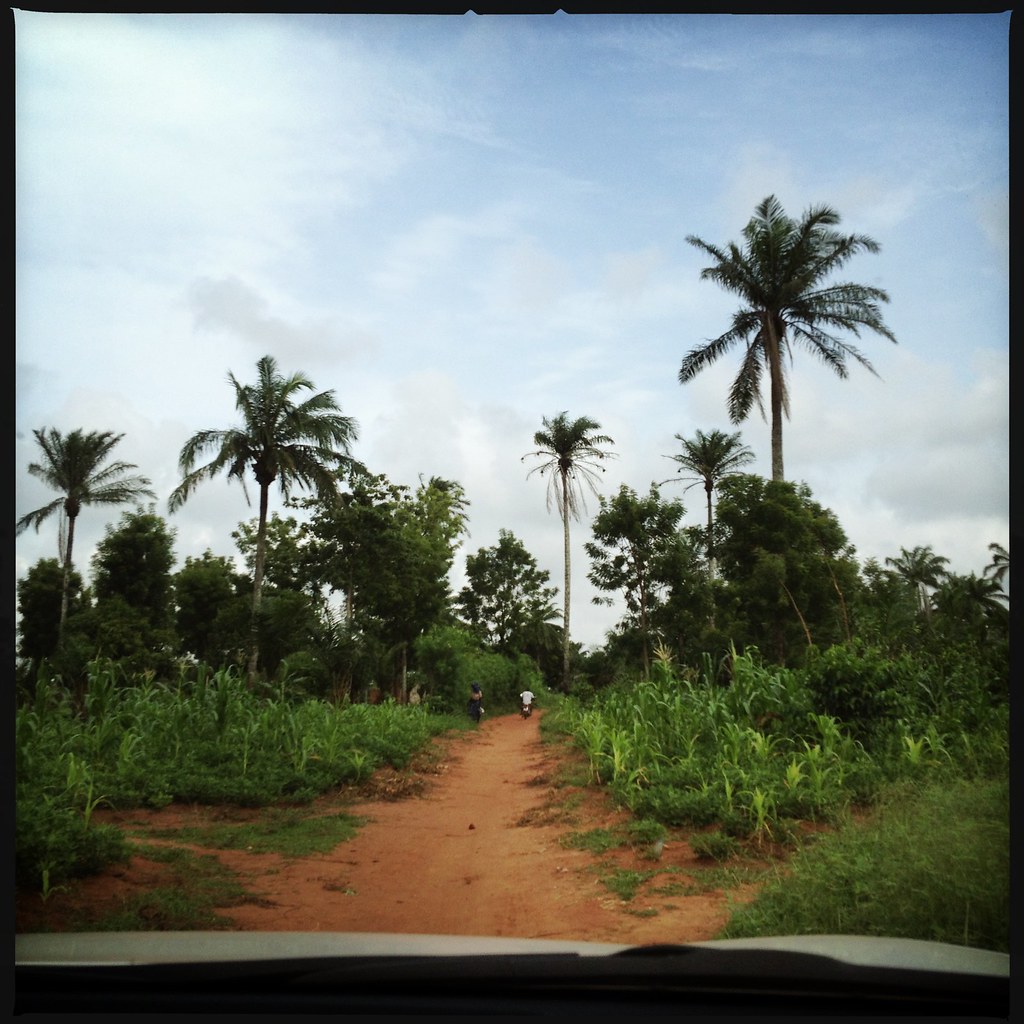
Once we turned off of the main highway we were on a very narrow dirt road that didn't appear to have much four-wheel motor vehicle traffic. There were clusters of mud huts. Once we got near the school it opened up into a dirt campus somewhat enclosed on three sides by cement buildings. First thing i noticed was the sign on the driveway entrance announcing the project and our involvement. It was exhilarating to see!

Getting out of the cars at each school we were greeted by wide smiles and curiosity. We were brought into school buildings where groups of students joined us. At the first school, the first thing we were treated to was a very moving spiritual song and dance. By the end of it, it had erupted into a dance off of excited children! It was awesome! I wanted to join in!!!
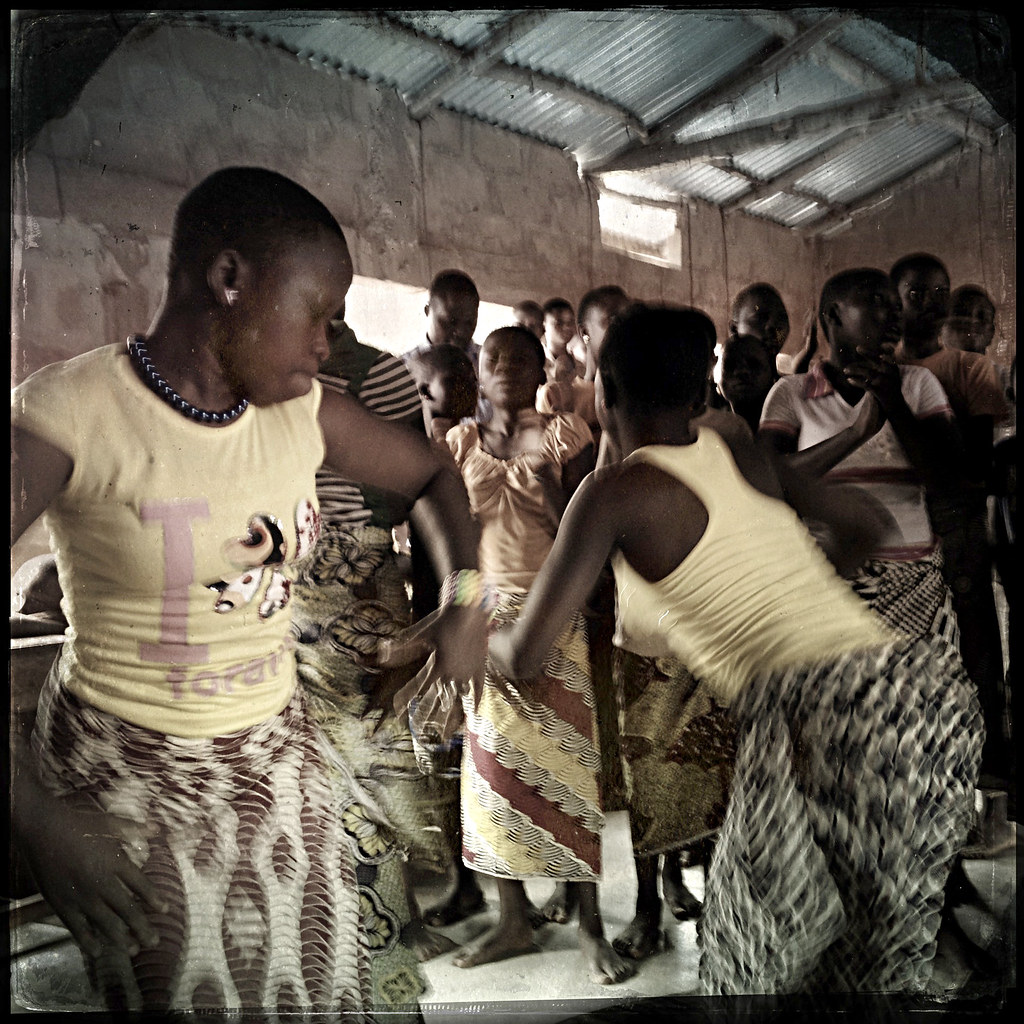
At another school we watched a group of students perform a skit for us. There was a father whose son came to him telling him he really needed to go to the bathroom and the father just told him to go out behind the house. (We saw all over Benin and Togo it's socially acceptable to urinate wherever you are and to go into the bushes to defecate. Cleaning up after? Washing hands? Not likely . . .) A minute later the young boy came back screaming in pain having been hit by a motorbike. Another variation on this scenario, we were told later, was while crouching down being bit lethally by a snake. This re-enactment was all to thank us for the much needed toilets and how it has improved their lives.
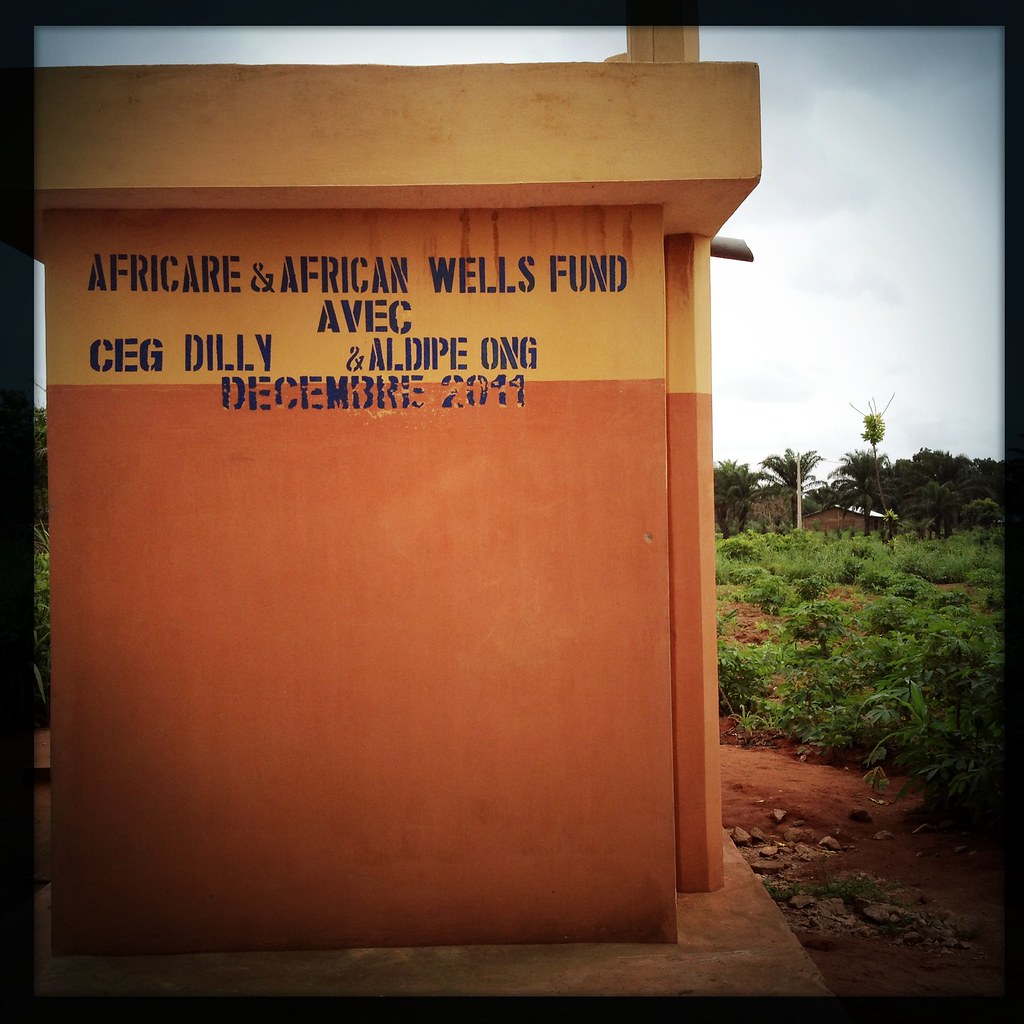
It still trips me out that something we in the USA take for granted, and don't even really think about in our day to day lives (unless you have Colitis like me), can make such a powerful change! A simple safe place to go the bathroom . . .
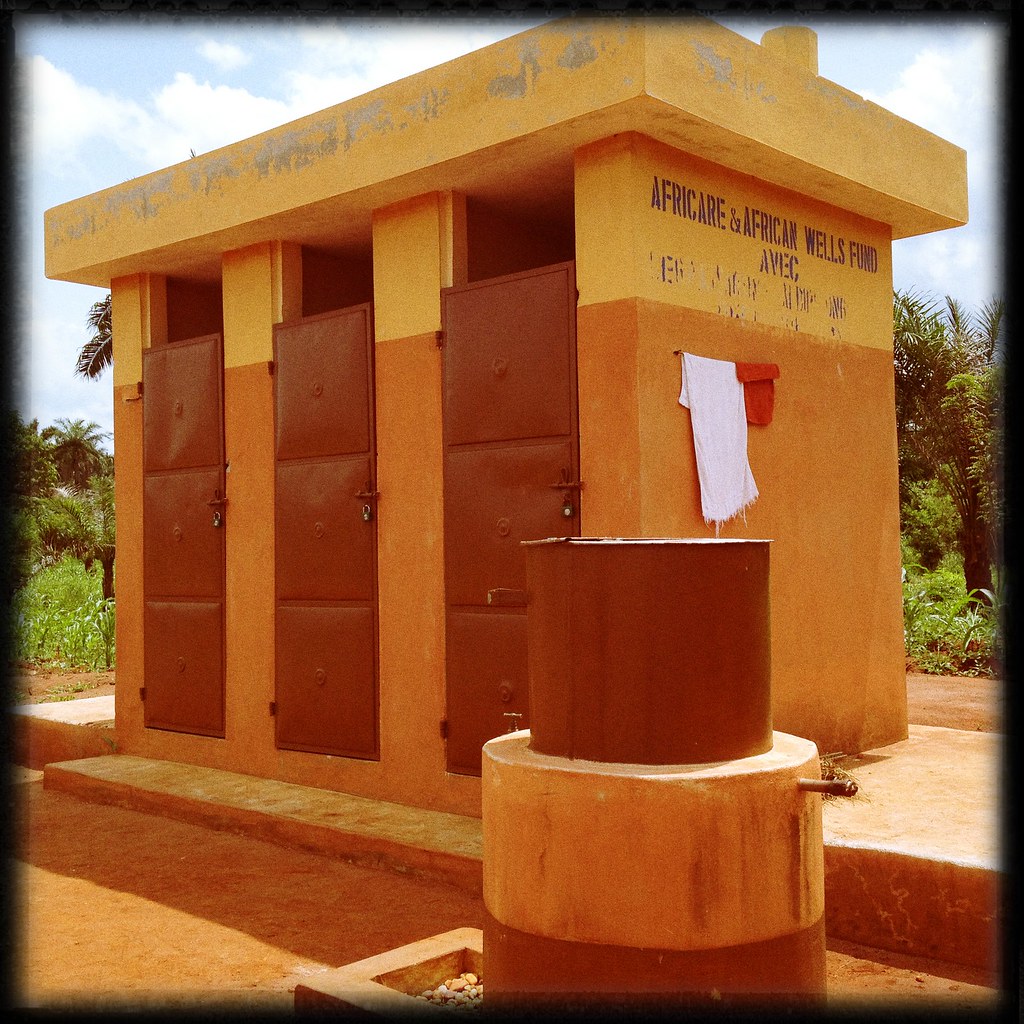
The latrines, unfortunately, have caused some negative repercussions in neighboring villages who are desperate to use them. The schools keep the stalls (usually 3) locked up so they can control the safety and integrity of them, but there were incidents reported to us of neighboring villagers trying to break the locks and even tear the doors off of them to get access. That really demonstrates the value of something we take for granted, I think.
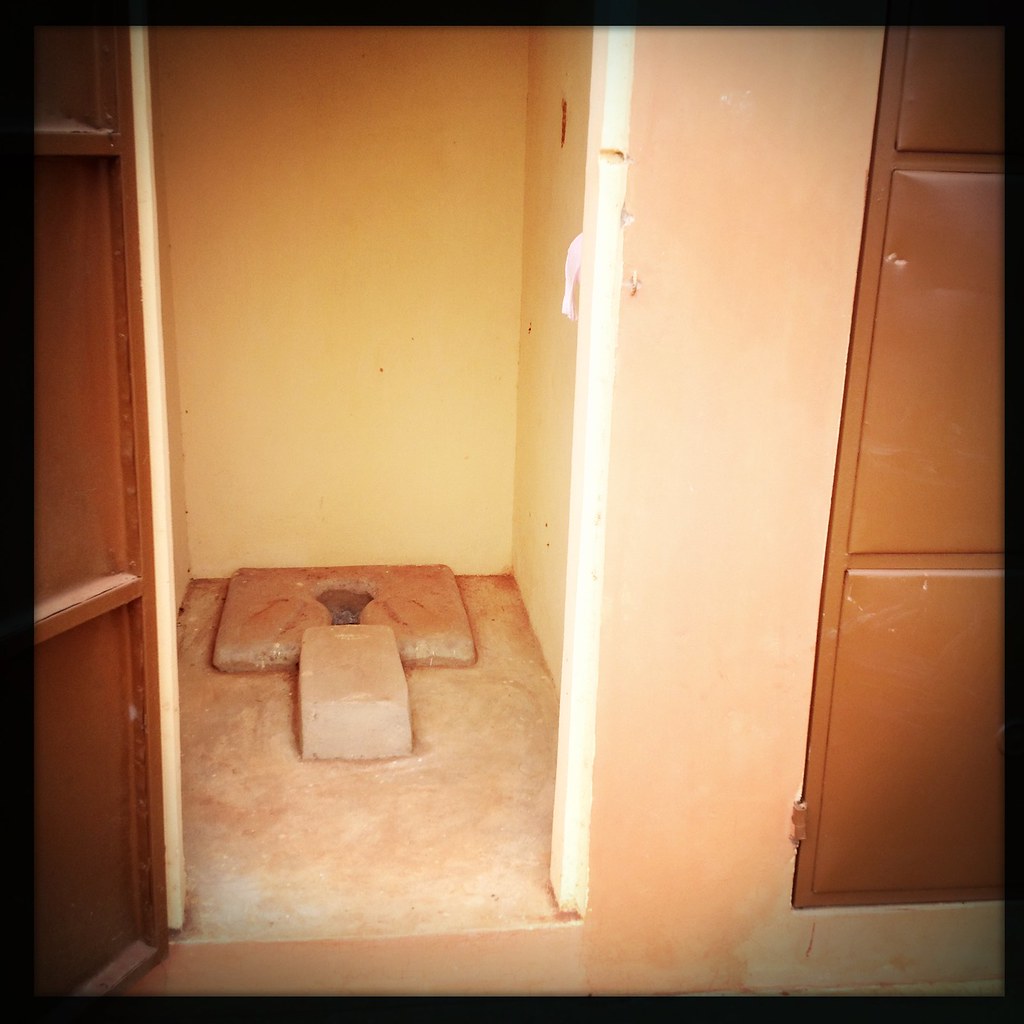
Part of the project was to educate school children on hygeine as most had never had access to a toilet before more over water to wash their hands with.

The well built at this school was also used by these four women whom were described to us as cooks. The schools don't have any sort of meal programs, and many children are there from 7am to 7pm as they live too far away to go home for a lunchbreak, so these women cook food and sell it to the children. They were very thankful for the well and water!
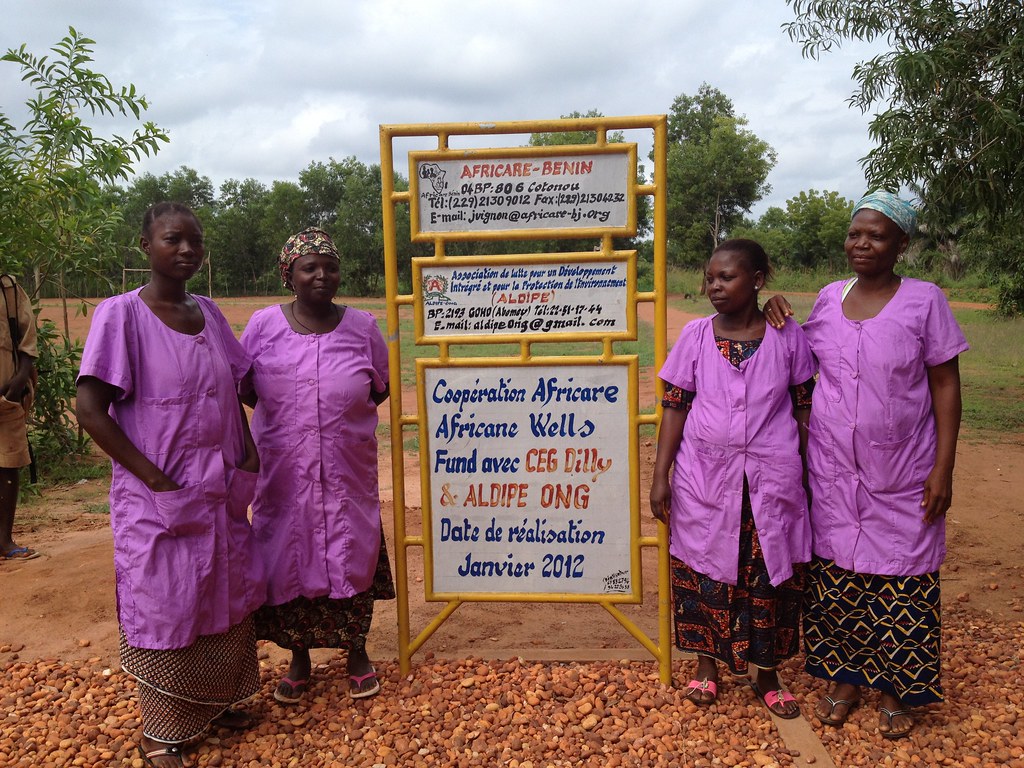
More photos of the beautiful children so full of life:
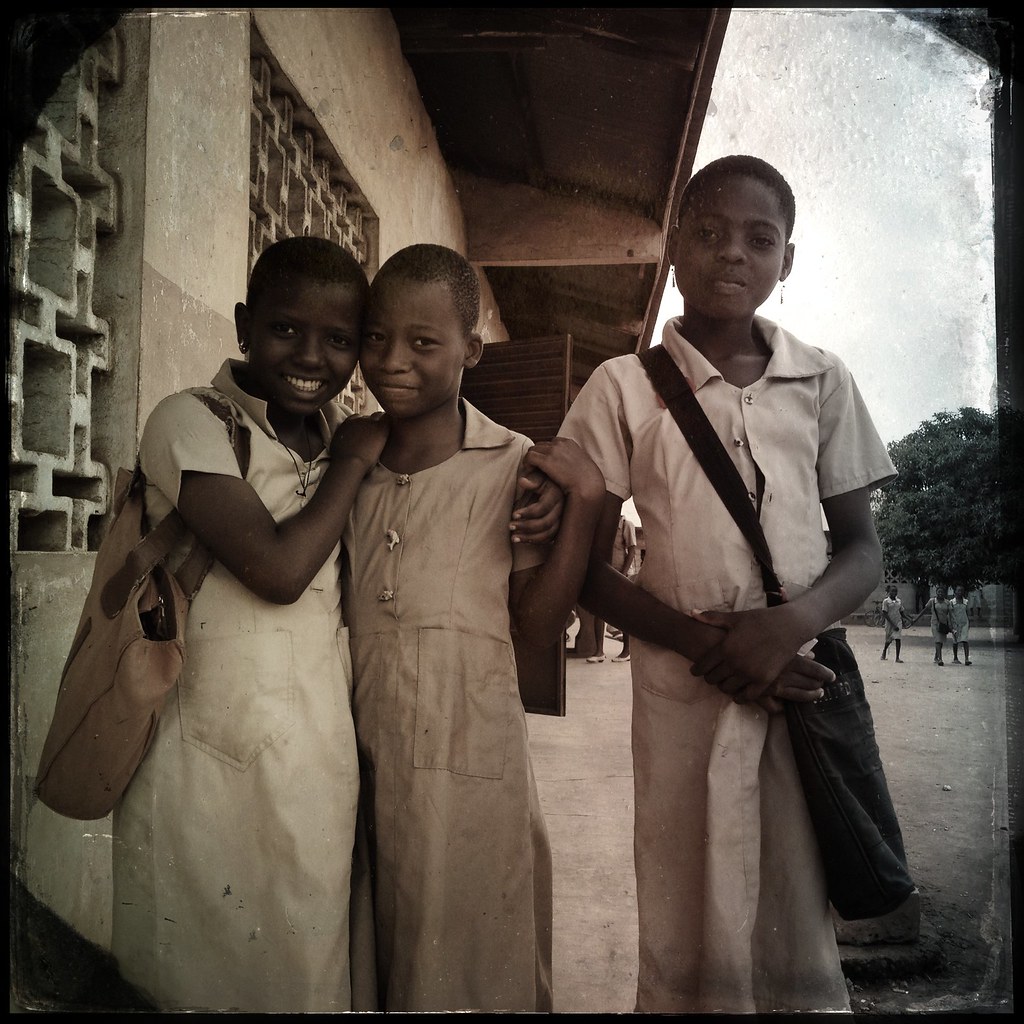

At one of the schools the head master started off by saying:
"Thank you for caring for children that are not your own."
These words have been haunting me since. There are so many ways to take that, but at it's simplest, I think it illustrates how hard life is for families in that area to just take care of their own families moreover other families. I'm not suggesting I don't believe there isn't neighborly favors being done, but there isnt much wealth to go around.
On another note that statement has just made me re-evaluate my own core values and what taught me in my life to believe in human equality and to notice those "who have" and have compassion for those "who have not" . . . Whether it be those early years in Hebrew school teaching me what a Mitzvah is, or being brought up by the most generous parents one could ask for, or having hero/role models like Adam Yauch and Bono (especially in my impressionable early 20s) . . . well, that's a whole other blog entry or conversation over wine.
So, instead let's look at one more photo of shiny faces full of hope and wisdom most of us will never attain.
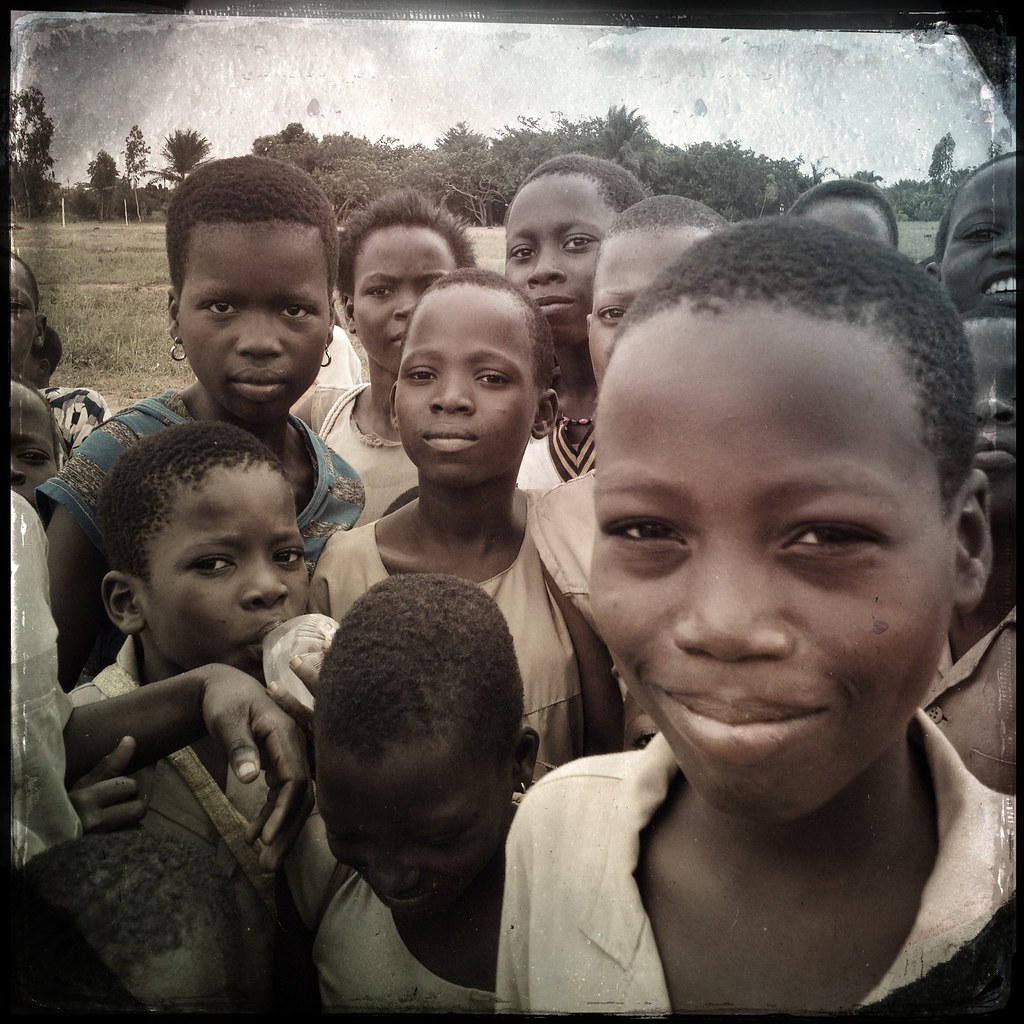
THANKS FOR READING!
And here are two other blog entries about this trip:
Tour of Ganvié
Initial Impressions of Togo
The day had come that was the impetus for this trip to West Africa. We were picked up before sunrise to make the long drive towards the north central part of Benin to visit the four schools that the WASH (Water and Sanitation Hygiene) component we had funded had taken place in.
Below is a personal recollection of the day:

I had no idea what to expect - I had seen photos of African Well Fund's previous trips to schools and project report photos from Africare, but as i had already learned it's a different thing to experience it. I was very conscious of my fear and excitement about whatever lay ahead.
The trip went through "urban" areas as well as heavily vegetated areas. The urban areas were much like we had already experienced - crazy traffic between autos and motocycles, people selling a myriad of goods, dirt, exhuast mixing with the heat.

One of the cities we drove through is Porto Novo, which is the capital of Benin. It was a strange mix of 19th century Brazillian colonial looking buildings and makeshift dwellings. Everything but the mosques and churches seem to be in disrepair or half built. We were told numerous construction projects start but never get finished. And when things start falling apart there really isnt money to hire people to repair.
As we made our way out of the city and toward Bohicon, where the schools are located, it became much more agricultural, although people were walking along the side of the highway as well as in the fields harvesting fruits and vegetables. Gender roles still appear to be clearly defined in the part of West Africa we were in. Men did the hunting and gathering, women cleaned, cooked and sold whatever was abundant in their village.
The roads we travelled were lined with women and their children selling fruits and vegetables, oils and peanuts. And the product was always concentrated within the same area - you'd see a dozen women all selling the same oranges or the same corn. These seemed to be the women whose families are probably the statistics we hear about - the ones living on less than a dollar a day just doing what they know to survive.
Recent statistics show that 5% of the population in this area actually has access to clean water.
FIVE PERCENT.

I felt way too guilty to take any of their photos from the car I was in, as it seemed a luxury at this point. However, this is the image I have designed in my head based on all the different things I saw as well as things I've learned over the years on the Internet:
The people we saw live in villages that have existed for generations and generations. Their housing is a shelter - mud huts with palm tree leafs covering. Dirt floors that are swept with pieces of bush. There is either a well for water that they and/or their children fill buckets and Geri cans from and carry it back to their homes or, as is the case for 95% of this population, no source of water nearby. In this case they walk with their children, sometimes up to 8 miles in a day, to find a stream or water hole where they can fill whatever it is they have and carry it home. The water they find is seldom clean, in that the same water might have also served as a toilet for wild animals as well as humans. The same water may have all sorts of bacteria, algae, and trash that is just kind of pushed aside and strained out. There are cows, goats, donkeys, chickens, dogs, ducks roaming all over the place and they use this same water. There also appears to be no sanitation system in Togo or Benin with trash piles constantly around you. In addition to having to spend hours a day fetching water the women and children face other real danger. Poisonous snakes, rape, physical violence . . . But the alternative of not having water to drink or cook with outweighs those dangers.These are the villages we try to help bring a well to. To free up all these women and children to do more empowering things with their days. Children can get an education, women have shown they can start more lucrative businesses, many lives are saved from the health benefits of not getting deathly ill from drinking and bathing in contaminated water as well as not exposing themselves to the peril that exists while looking for water.
. . . i digress and climb down from the soapbox . . .

Once we turned off of the main highway we were on a very narrow dirt road that didn't appear to have much four-wheel motor vehicle traffic. There were clusters of mud huts. Once we got near the school it opened up into a dirt campus somewhat enclosed on three sides by cement buildings. First thing i noticed was the sign on the driveway entrance announcing the project and our involvement. It was exhilarating to see!

Getting out of the cars at each school we were greeted by wide smiles and curiosity. We were brought into school buildings where groups of students joined us. At the first school, the first thing we were treated to was a very moving spiritual song and dance. By the end of it, it had erupted into a dance off of excited children! It was awesome! I wanted to join in!!!

At another school we watched a group of students perform a skit for us. There was a father whose son came to him telling him he really needed to go to the bathroom and the father just told him to go out behind the house. (We saw all over Benin and Togo it's socially acceptable to urinate wherever you are and to go into the bushes to defecate. Cleaning up after? Washing hands? Not likely . . .) A minute later the young boy came back screaming in pain having been hit by a motorbike. Another variation on this scenario, we were told later, was while crouching down being bit lethally by a snake. This re-enactment was all to thank us for the much needed toilets and how it has improved their lives.

It still trips me out that something we in the USA take for granted, and don't even really think about in our day to day lives (unless you have Colitis like me), can make such a powerful change! A simple safe place to go the bathroom . . .

The latrines, unfortunately, have caused some negative repercussions in neighboring villages who are desperate to use them. The schools keep the stalls (usually 3) locked up so they can control the safety and integrity of them, but there were incidents reported to us of neighboring villagers trying to break the locks and even tear the doors off of them to get access. That really demonstrates the value of something we take for granted, I think.

Part of the project was to educate school children on hygeine as most had never had access to a toilet before more over water to wash their hands with.

The well built at this school was also used by these four women whom were described to us as cooks. The schools don't have any sort of meal programs, and many children are there from 7am to 7pm as they live too far away to go home for a lunchbreak, so these women cook food and sell it to the children. They were very thankful for the well and water!

More photos of the beautiful children so full of life:


At one of the schools the head master started off by saying:
"Thank you for caring for children that are not your own."
These words have been haunting me since. There are so many ways to take that, but at it's simplest, I think it illustrates how hard life is for families in that area to just take care of their own families moreover other families. I'm not suggesting I don't believe there isn't neighborly favors being done, but there isnt much wealth to go around.
On another note that statement has just made me re-evaluate my own core values and what taught me in my life to believe in human equality and to notice those "who have" and have compassion for those "who have not" . . . Whether it be those early years in Hebrew school teaching me what a Mitzvah is, or being brought up by the most generous parents one could ask for, or having hero/role models like Adam Yauch and Bono (especially in my impressionable early 20s) . . . well, that's a whole other blog entry or conversation over wine.
So, instead let's look at one more photo of shiny faces full of hope and wisdom most of us will never attain.

THANKS FOR READING!
And here are two other blog entries about this trip:
Tour of Ganvié
Initial Impressions of Togo
Tour of Ganvié, Benin, Hipstamatic Style
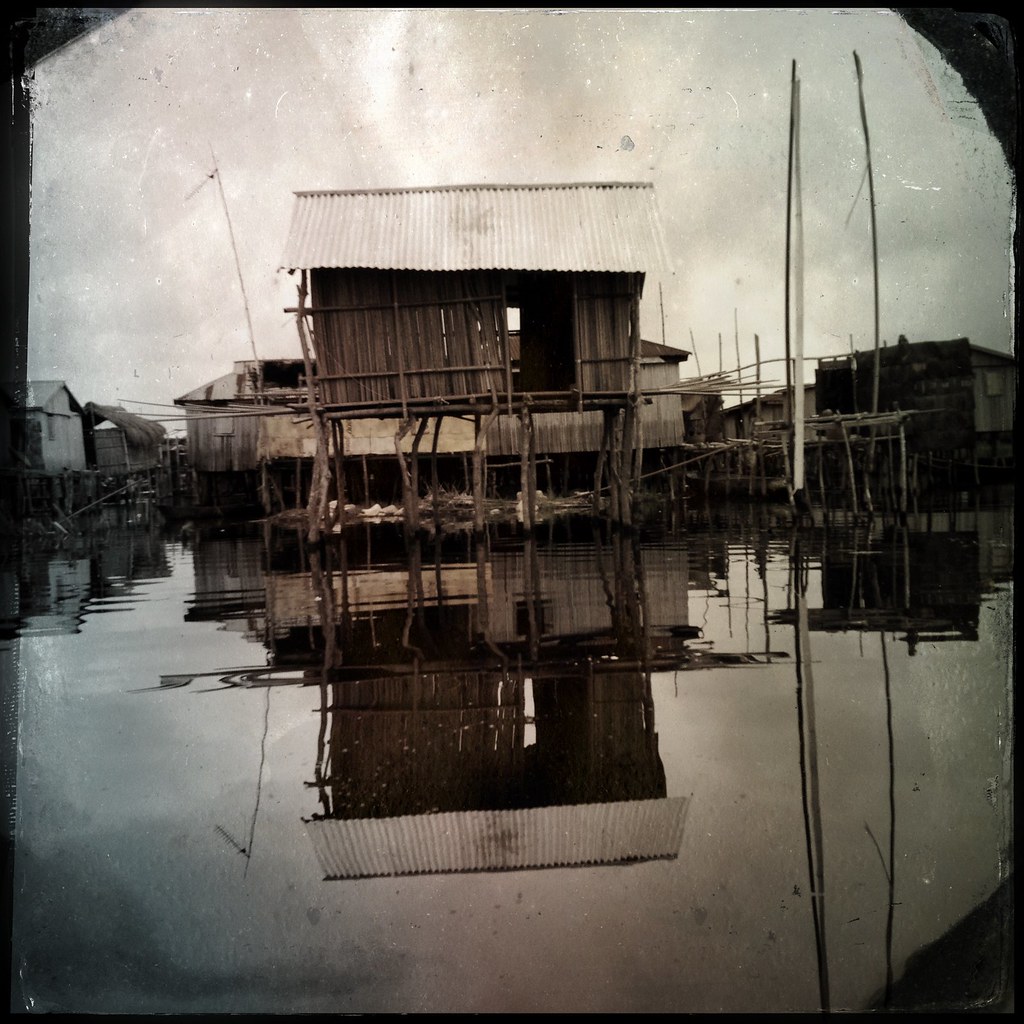
On the first full "free" day we had in Benin we decided to visit Ganvié, a city in Lake Nokoué, made up of houses built on stilts. The city is about 500 years old and was founded by people trying to escape slavery.
The internets tell the story like this:
At the beginning of the seventeenth century the country was called Dahomey and was one of the most powerful states in West Africa. The major ethnic and linguistic group was the Fon and they had made a deal with the Portuguese. Rather than their own people being captured and sold in to slavery they made a contract with the Portuguese to hunt and sell tribes people from smaller ethnic groups.
The Fon warriors were numerous and powerful and there was little other groups of people could do to defend themselves against this onslaught. Then, someone among the Tofinu people came up with an idea. Their name is lost to history but one wise person realized that they could take advantage of the religious practices of their enemy.
The Fon were forbidden by their religion to advance upon and water bound settlement. Any groups of people who lived on water were, by the law of the Fon, safe. Lake Nokoué is simply immense. Ganvié was established as a means to escape being sold in to a lifetime’s slavery and shipped across the world in appalling conditions. No wonder its name means the collectivity of those who found peace at last. The alternative translation is the much more to the point We Survived.
The people of Ganvié are still, centuries later, reluctant to move to solid ground, although the threat of slavery is only a distant memory. They have, over many generations, grown accustomed to living on the water, and have no desire to abandon their unique lifestyle, for anything. This unique African village is completely sustainable, and the only time villagers go ashore is when they want to sell their fish.Approaching Ganvié was a site to behold. Dirt road with a small bustling market of people selling and buying. It was obvious fish was the main product here. Cows and goats were roaming the streets. As like other parts of Benin and Togo we saw, there is no organized disposal system so mounds of trash could be found everywhere. This is also where you would find the cows and goats grazing for their meals.
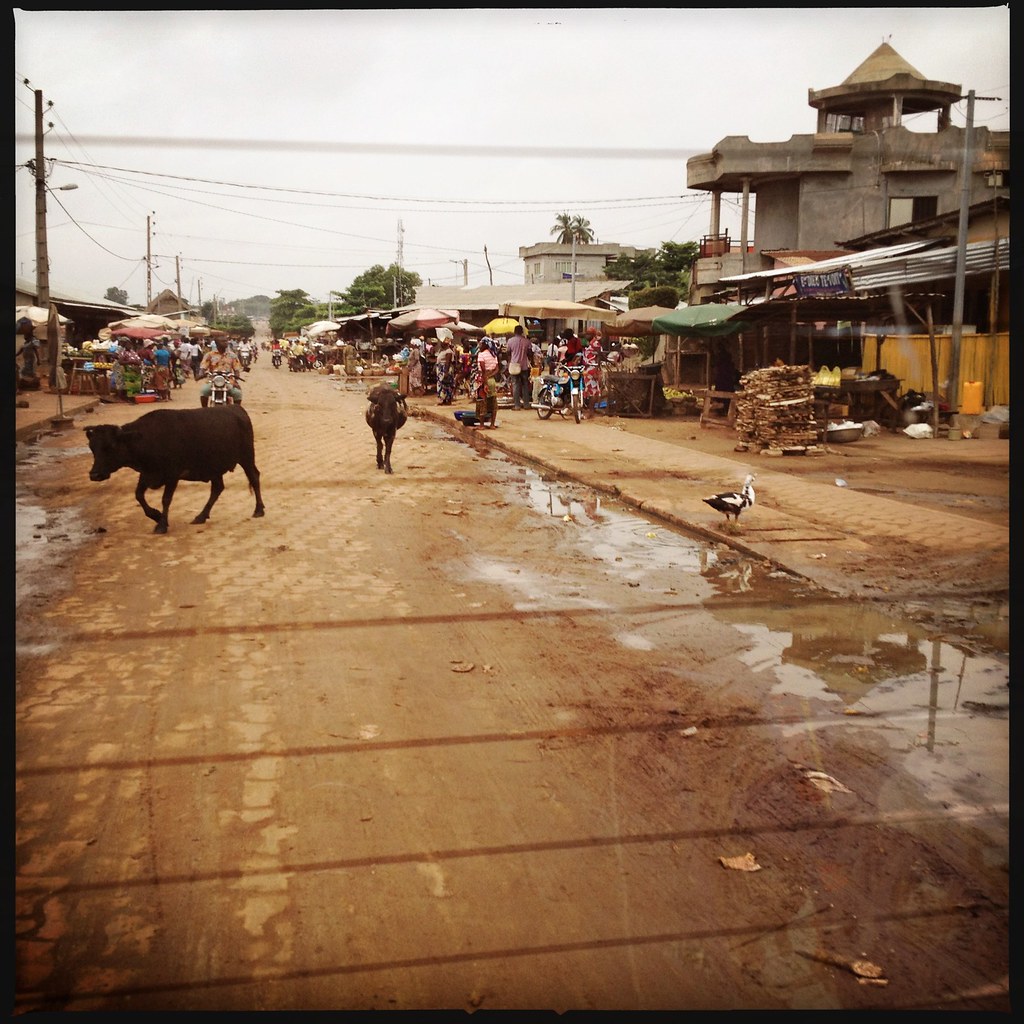
As we had already noticed with the rest of our trip to Togo and Benin, it is the women that do the selling and business. Gender roles still seem extremely defined with men fishing and hunting and women and older children preparing and selling the fruits of the men's labor. I read somewhere on the internets that men sell their fish to their wives who are then responsible for selling it to the public.
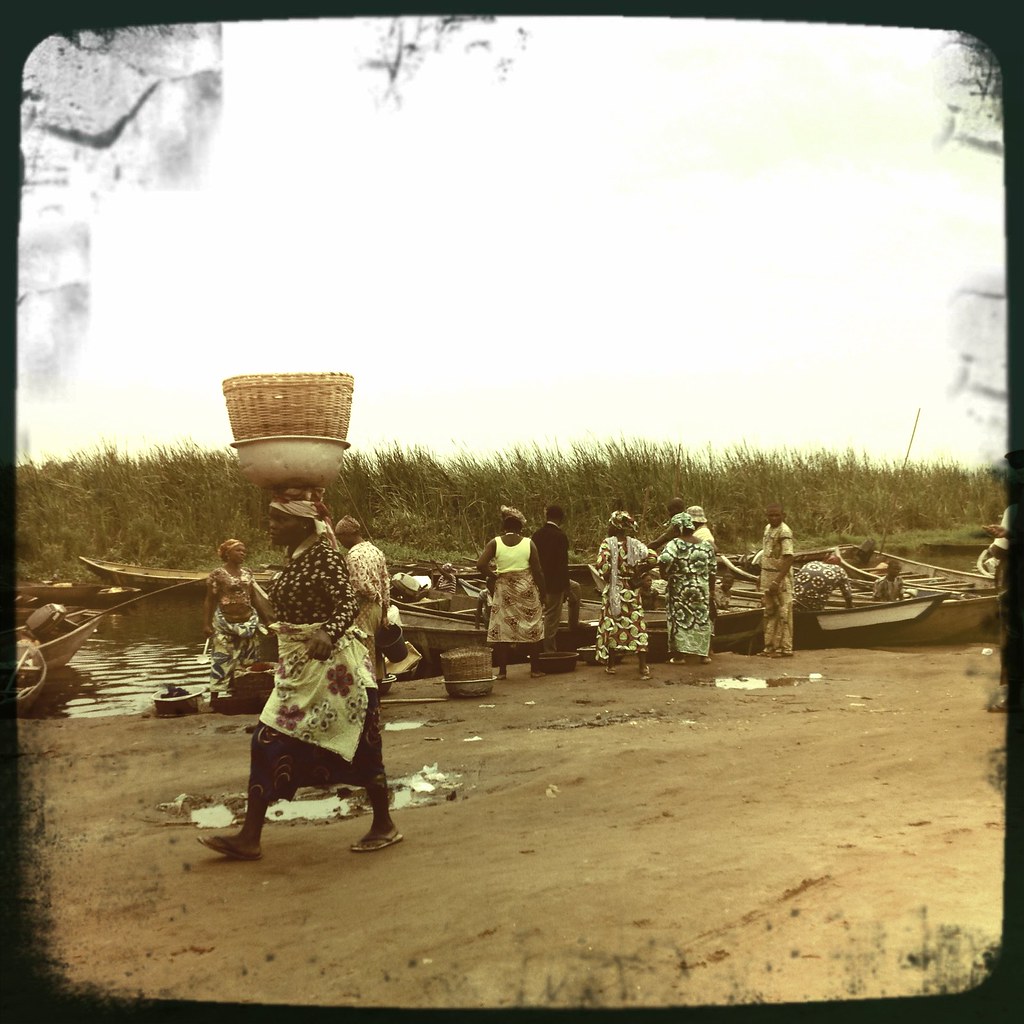
I saw many a young woman scaling fish that was still writhing around or carrying trays of fresh catches on their heads down the street. I have very few photos of actual people from Ganvié as they are extremely resistant to photos being taken. I've heard they believe a photo steals their soul. It wasn't unusual to see people turn their heads or cover their faces with baskets when they saw us assuming we would probably take their photo. In fact, this woman in the photo below got quite unhappy and yelled at me for taking her photo which pretty much put me in my place after that!
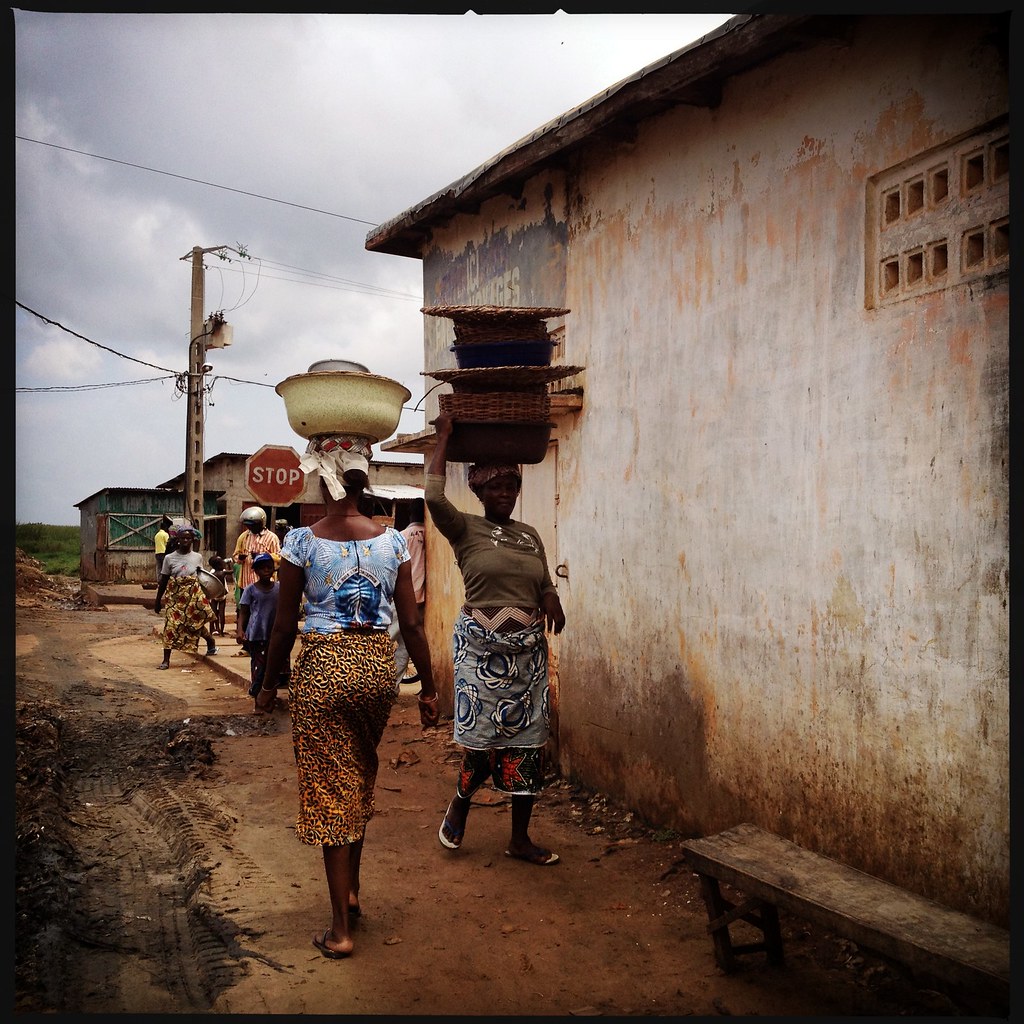
As we made our way to the boat docks to find our canoe we were either greeted by wary stares or extremely friendly children. This young boy was very excited to pose for photos and, of course, after asked for money. Unfortunately, none of us had any change. (As an aside it was an ongoing challenge for us to have change and small bills as most merchants wouldn't take the large bills the ATMs inconveniently gave us).
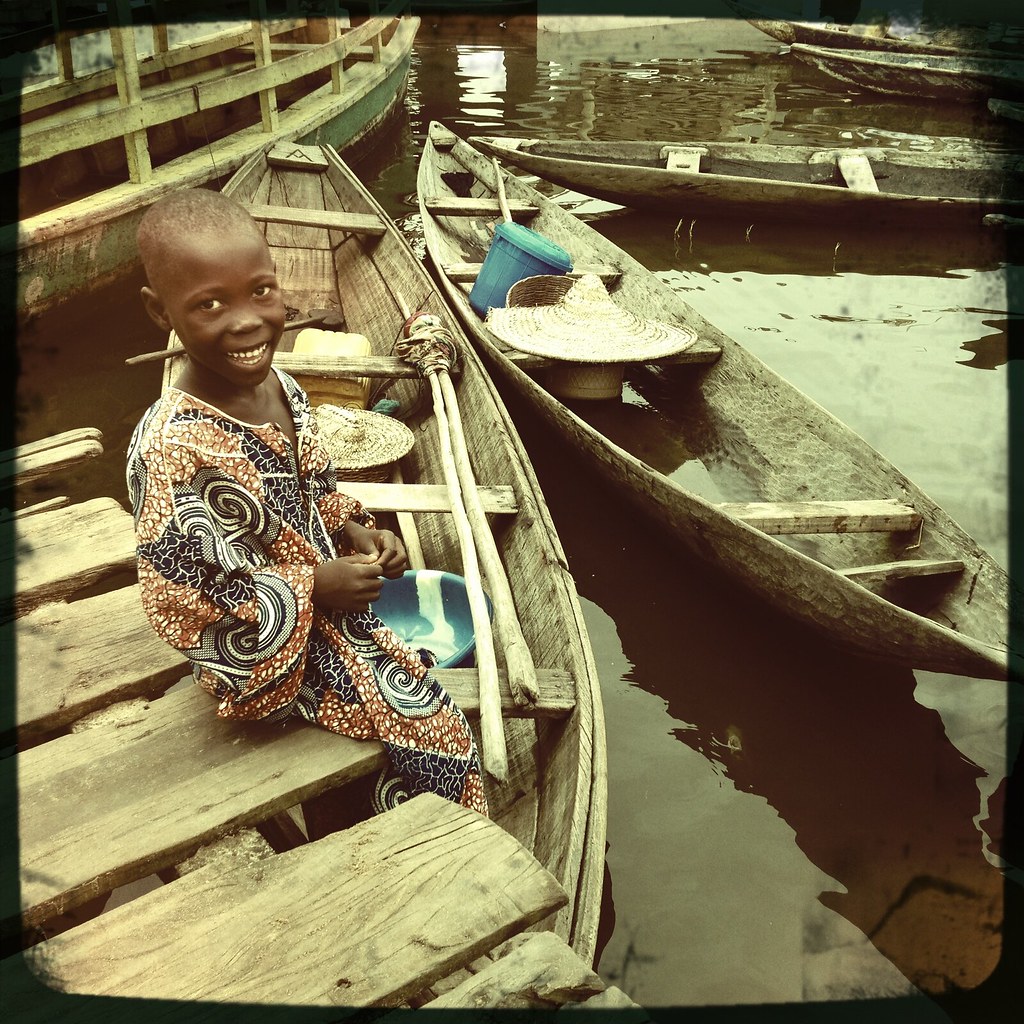
We got into our handmade canoe with trepidation. I can not say I wasn't on the verge of a panic attack as well as perhaps a few others in our group as the canoe had small leaks in it and was very close to the water (not above it like other vessels most of us are used to being on including "American" canoes). There was no motors, just two men with paddles.
As we made our way out to the city in the middle of the lake (it probably took a good hour to an hour and a half to paddle to) we learned of the ways fish are harvested which appear to have not changed much over time.

There were some areas with nets set up on stakes but mostly the fishermen stalked the natural vegetation in the lake, creating boundaries of ownership, where fish were drawn to eat and then caught. Some of these areas had makeshift security huts built to keep watch over, others, I'm still not quite sure how they were kept sectioned off from other farmers. Each of the little bunches of vegetation in the below photo served as fish bait.
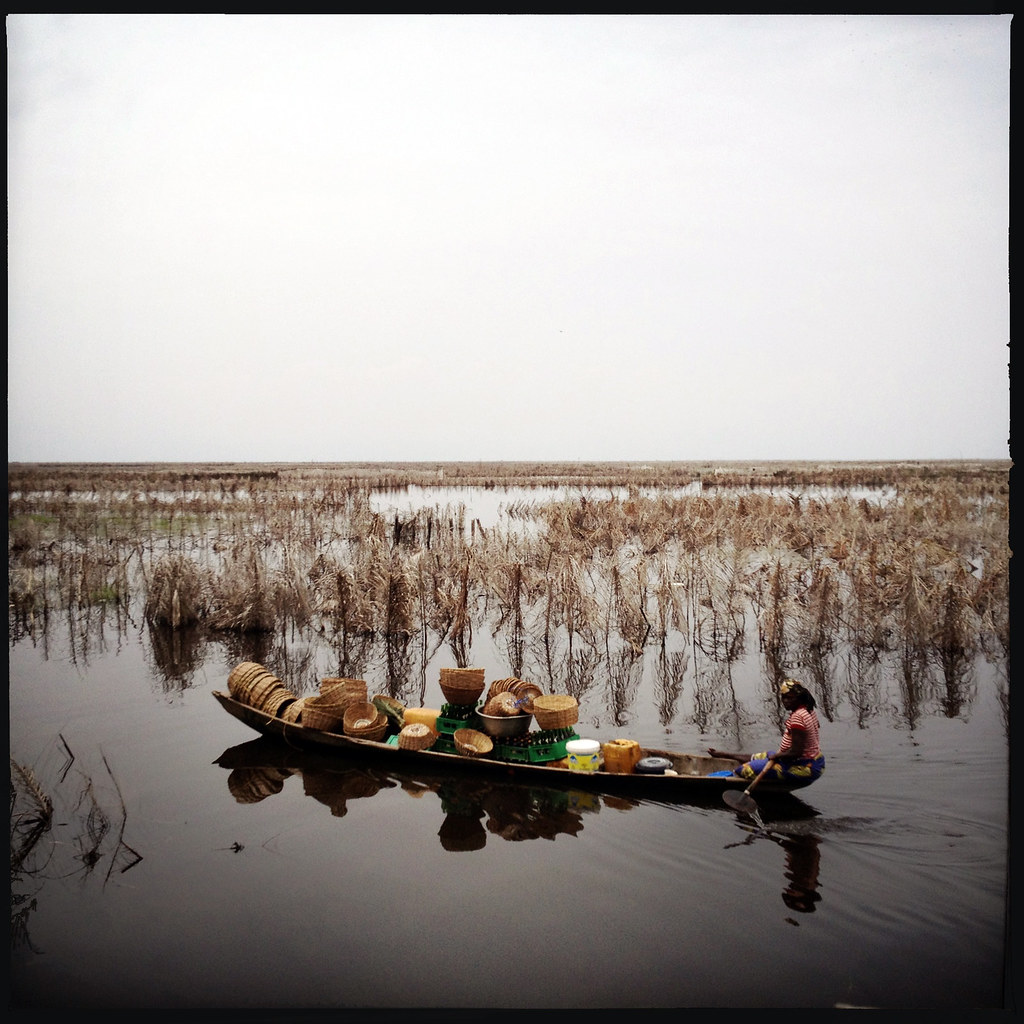
Very rarely did we see women fishing (if at all). Mostly they were paddling between the land and their village. Slow and steady. Singing. We were told they sing when they're tired to make the paddling easier.
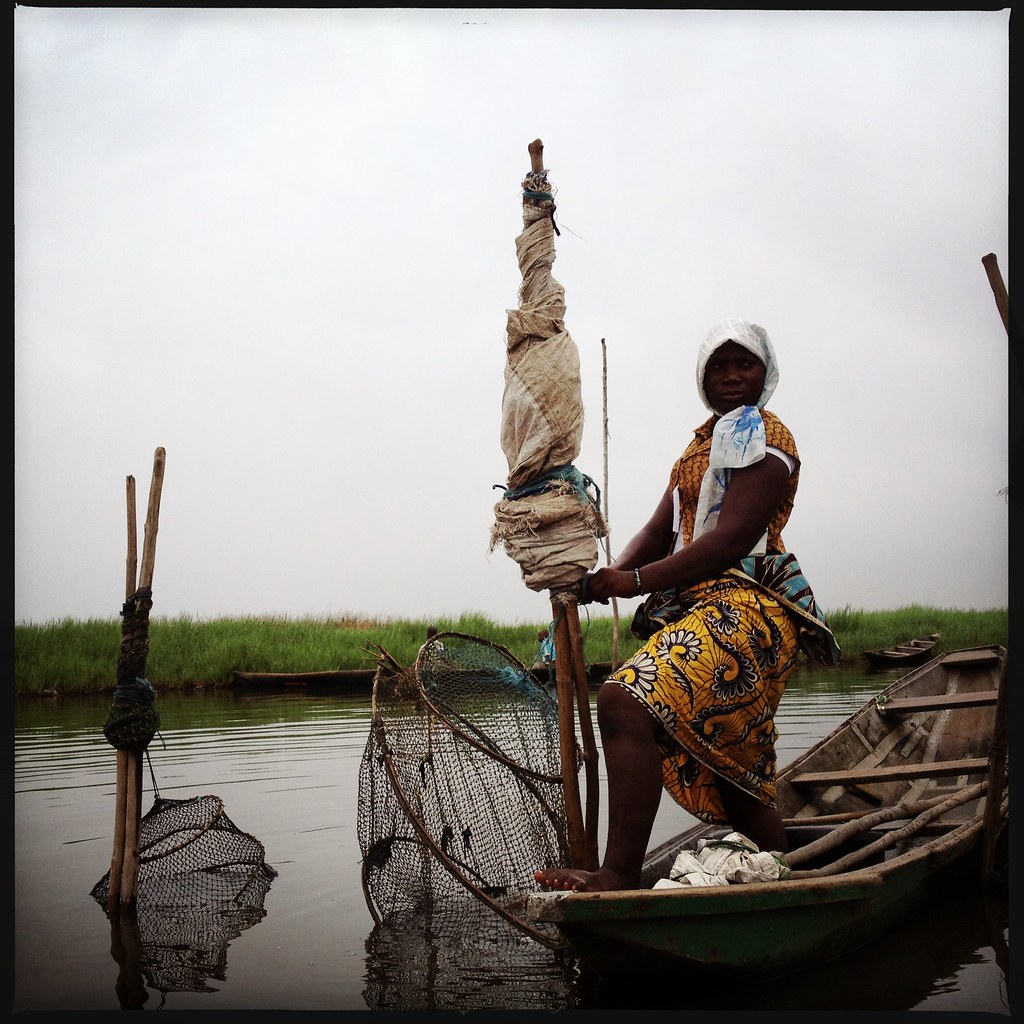
Some rather friendly fishermen we passed:

As we approached Ganvié the houses really were on stilts. You could see right underneath them!
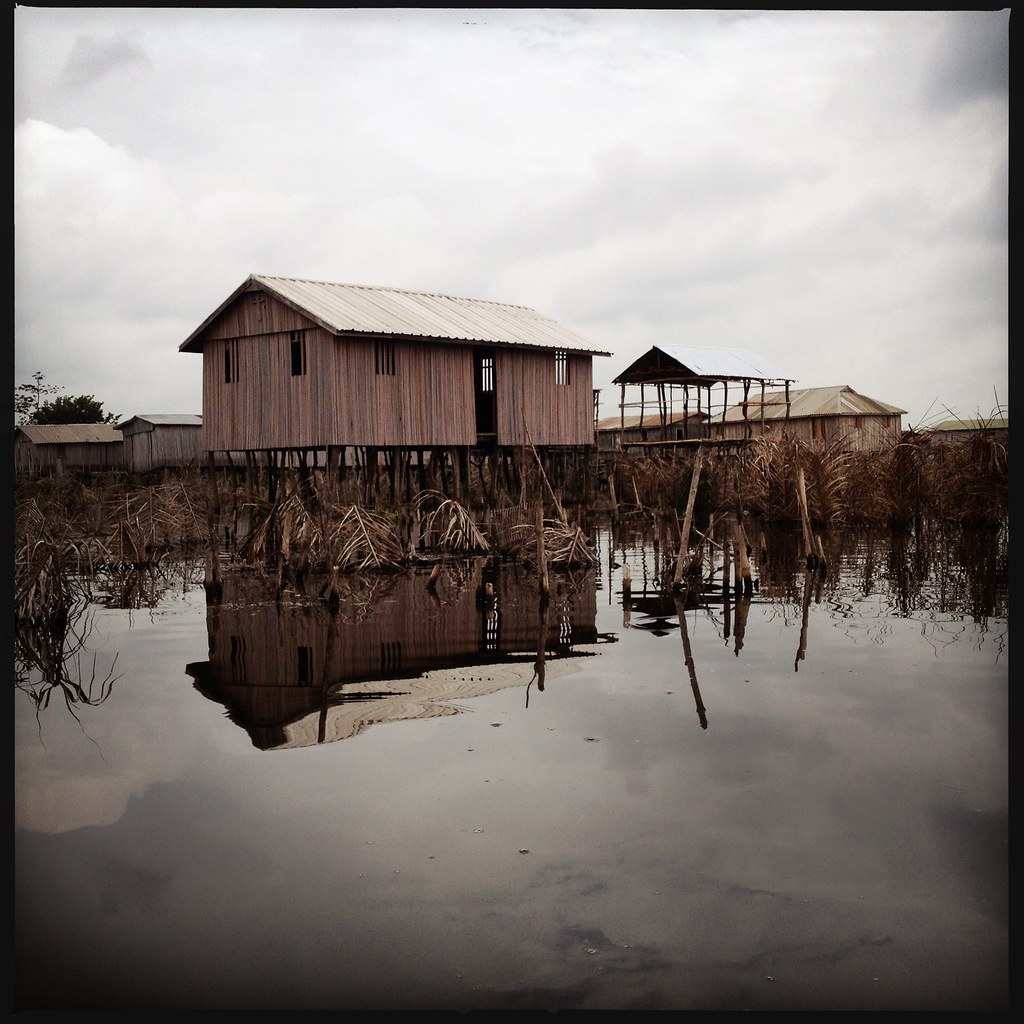
And indeed it was a city, with neighborhoods, and canals that, like in Venice, had street names. There was even a "street" called something like "lovers lane" in which in the evening young men and women take their canoes out to "cruise."
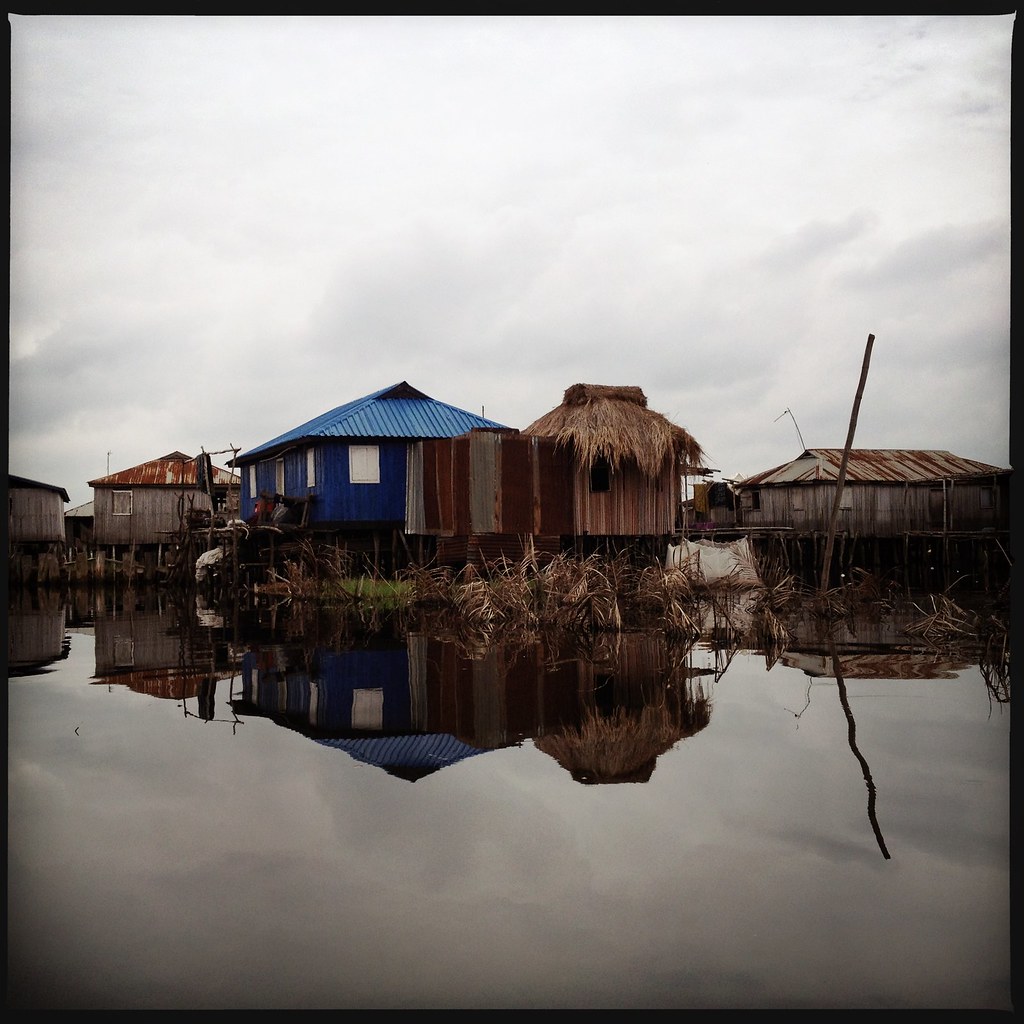
We were there early afternoon which appeared to be a pretty high traffic time of day for doing errands. It was all women and children doing the canoeing and had things like water vessels in their canoes and bowls of different things. They were all masters of maneuerving their boats around as well. A few times i was sure there would be collisions but there never was.

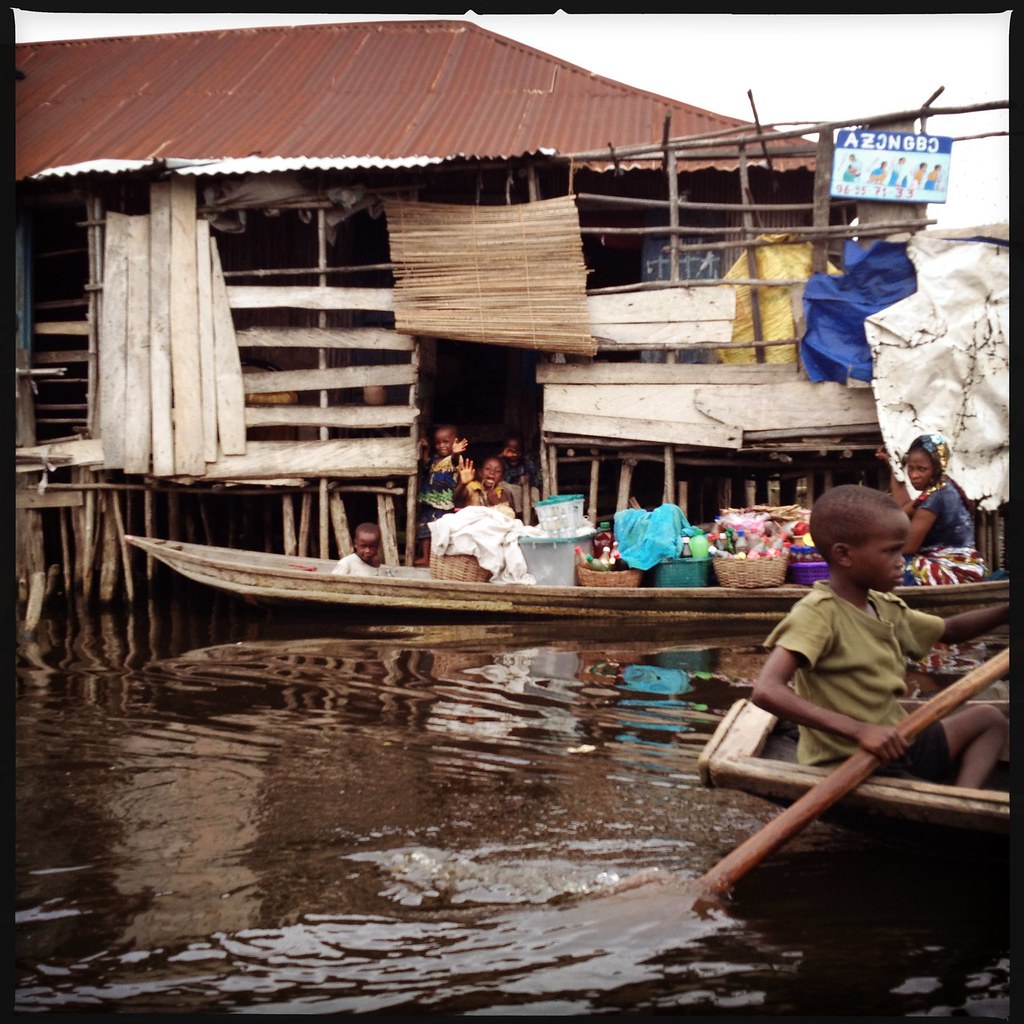

Ganvié has many of the same things any city would have, a medical clinic, a restaurant, a hotel, a convenience store and a church. This was the only structure i saw that didn't appear to be cobbled together by whatever materials could be found. The ground it was built on was created by the community going into the main land and bringing back soil.
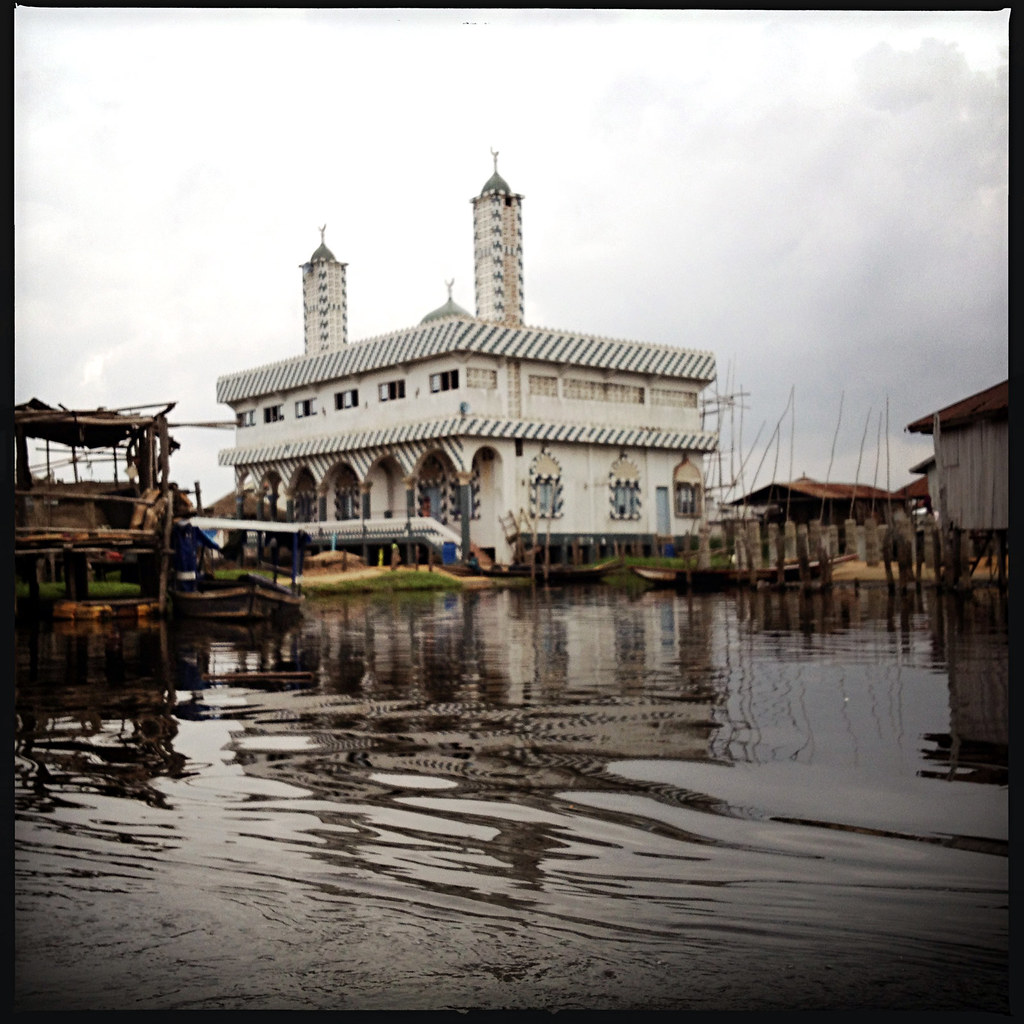
On the way back, as a fun photo, we took this of ourselves and boatsman, named "Junior" as i recall, whom in a very surreal way had our taxi driver who was also there take out his cell phone and play a song by Akon. I guess he's a popular artist both in America and Africa with the kids.
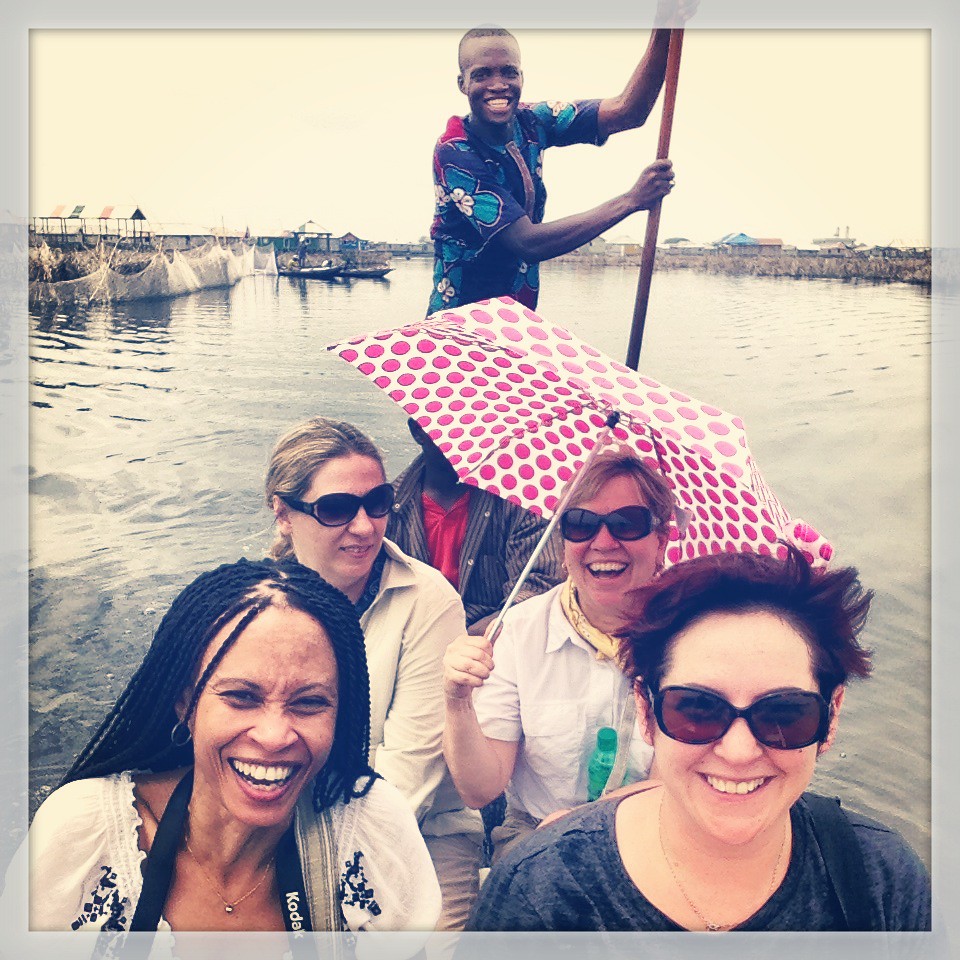
For other blog posts about this trip:
Initial Impressions of Togo
